I think I first used Liverpool Street Station around 1974, and from 1979 to 1989 I used the station every working day. It is one of my regrets that in all those years I did not take a single photo of the station. Too busy with work and other commitments, the station was also a very familiar sight that I used every day, so why take a photo?
This was a time of slam door trains, carriages with individual compartments, which had a single bench seat along either side of the carriage. Always difficult when you got into one of these compartments which appeared full, but could you squeeze into a gap, and would people shuffle up? Reading your neighbour’s newspaper as they opened it up in front of you.
This is probably why I over compensate now, and take photos of almost everything. The present becomes the past very quickly.
Fortunately my father did take a couple of photos of Liverpool Street Station in 1952. Not the main buildings of the station, but from the far end of the platforms, looking back into the station:
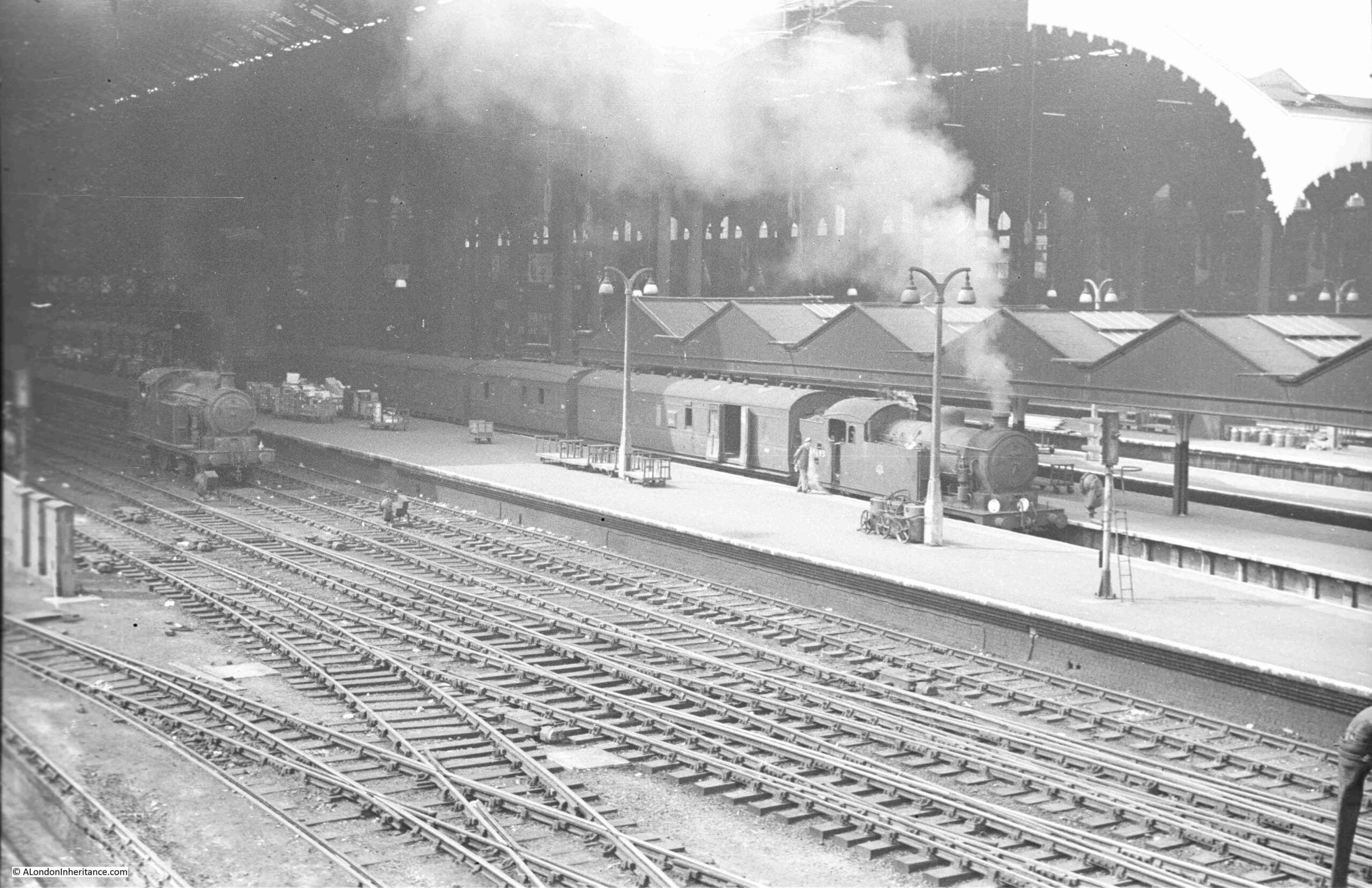
The photo was taken from a rather good viewing point if you wanted to watch trains arriving at, and leaving the station.
The platforms at Liverpool Street Station are slightly below ground level. Not that much, but enough to mean that the tracks left the station in a rather wide cutting with brick retaining walls on either side, and the tracks passing under what were streets, which had been converted to a bridge structure when the tracks were built.
The following map extract is from the 1951 revision of the OS map, so about the same time as my father’s photos. There are two streets crossing the tracks as they leave the station, Pindar Street and Primrose Street.
Pindar Street is closet to the station, and I have marked the location where I believe my father was standing with a red circle (‘Reproduced with the permission of the National Library of Scotland“).
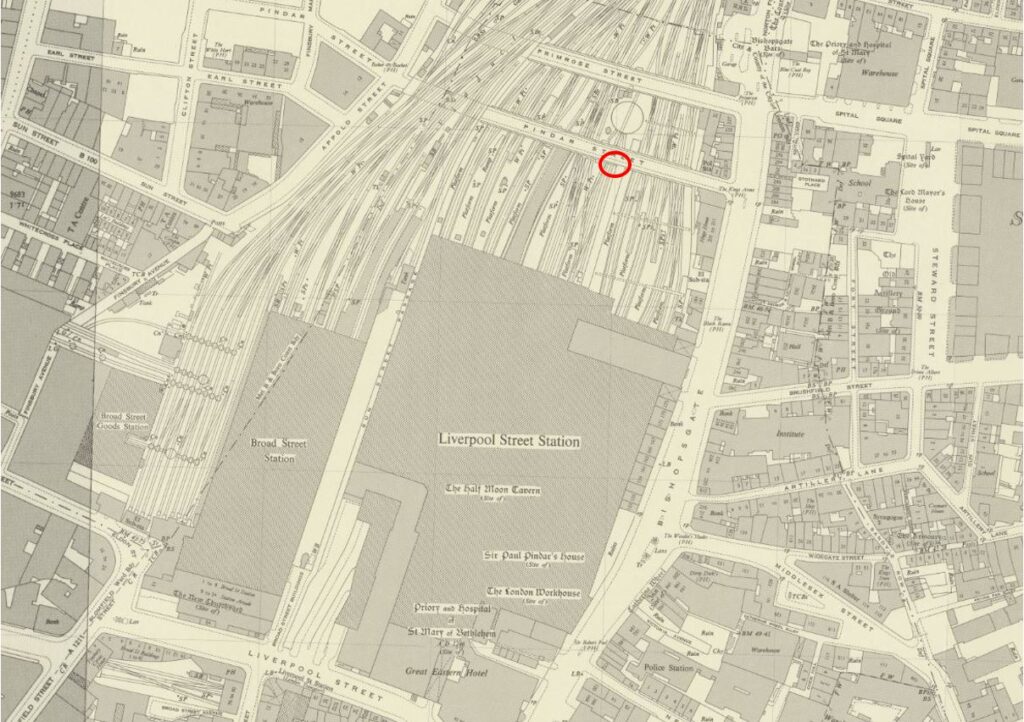
What really helped to confirm the location was finding the following photo of the area on the Britain from Above web site:
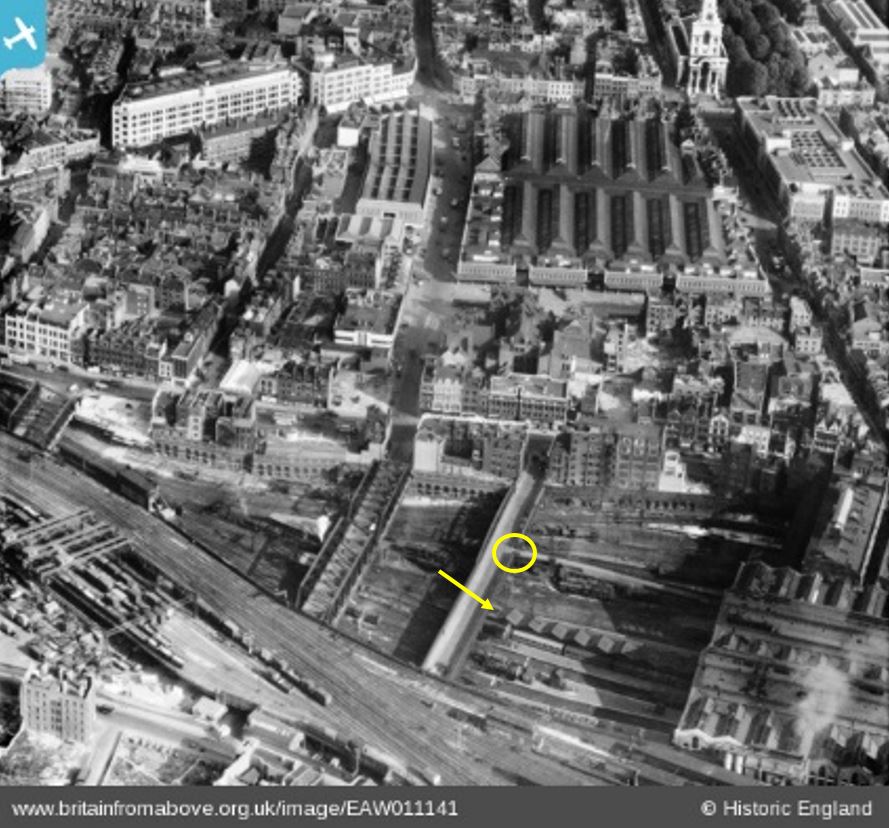
The photo is dated 1947 and shows Liverpool Street Station in the lower right corner, and Pindar and Primrose Streets crossing the tracks leaving Liverpool Street.
The above photo also shows the different approach between Liverpool and Broad Street Stations. Broad Street was next to Liverpool Street, and in the above photo the tracks into Broad Street pass over the streets, where the tracks into Liverpool Street pass under.
The two station platform levels were at different heights. I did take a couple of photos of Broad Street Station in 1986, before it was demolished (see my post on Broad Street Station here). It can be seen on the photos that the station buildings and platforms were higher than those of Liverpool Street.
I have marked the location where my father was standing with a yellow circle in the above photo.
The photo shows that there is a road / ramp leading down from Pindar Street to the station, which would have provided an unobstructed view, also I have marked with a yellow arrow a series of sheds where the roofs form a distinctive pattern. These sheds can be seen in my father’s photo.
I cannot find the exact location from where the following photo was taken, it may have been turning to the left from the above photo, or further along Pindar Street:
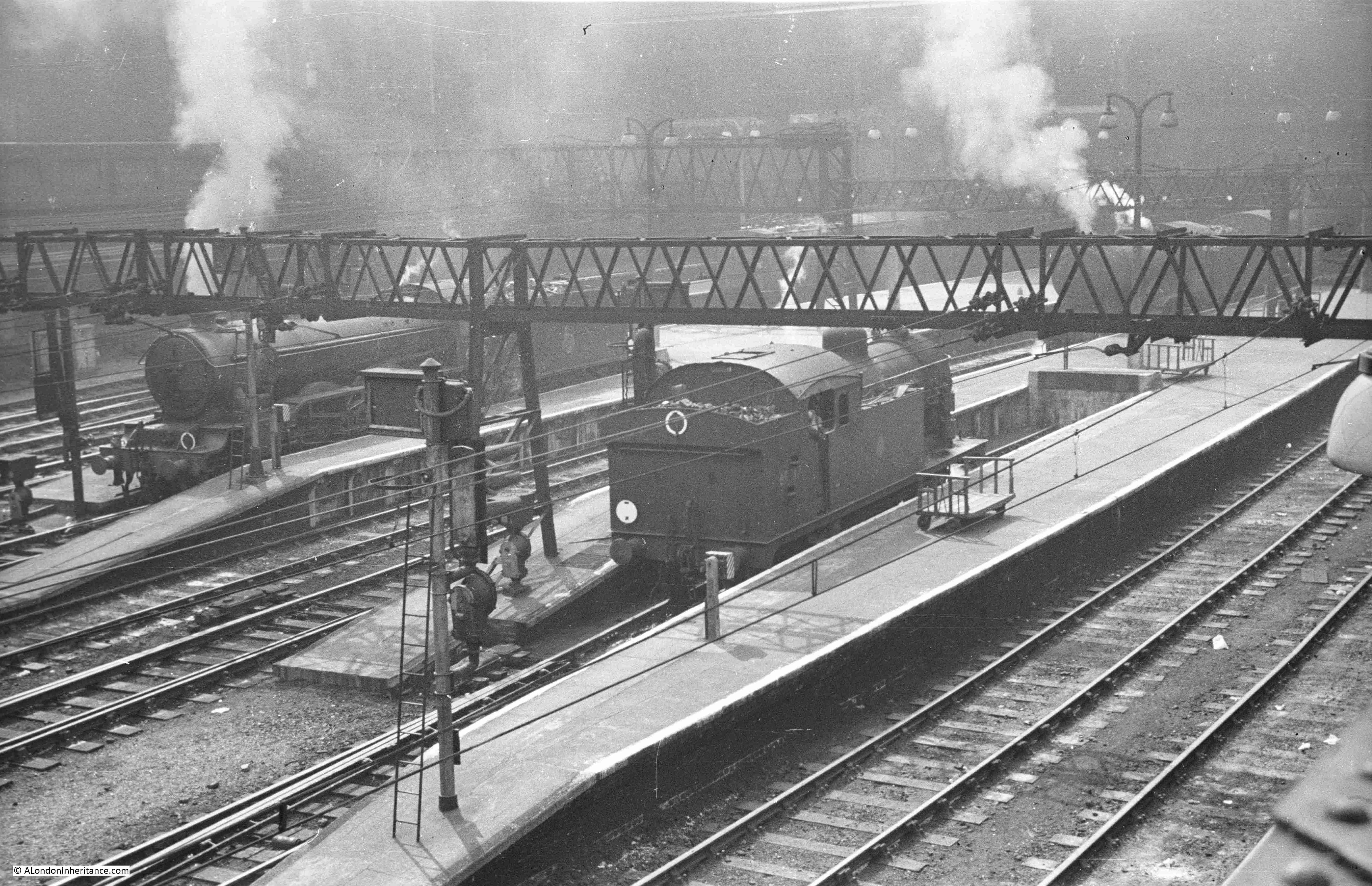
I wanted to try and get a photo from the same position today, and although the area around Liverpool Street Station has changed beyond all recognition, I was able to get to a similar position.
The following photo from the top of the Heron Tower / 110 Bishopsgate helps put the location of the station in context.
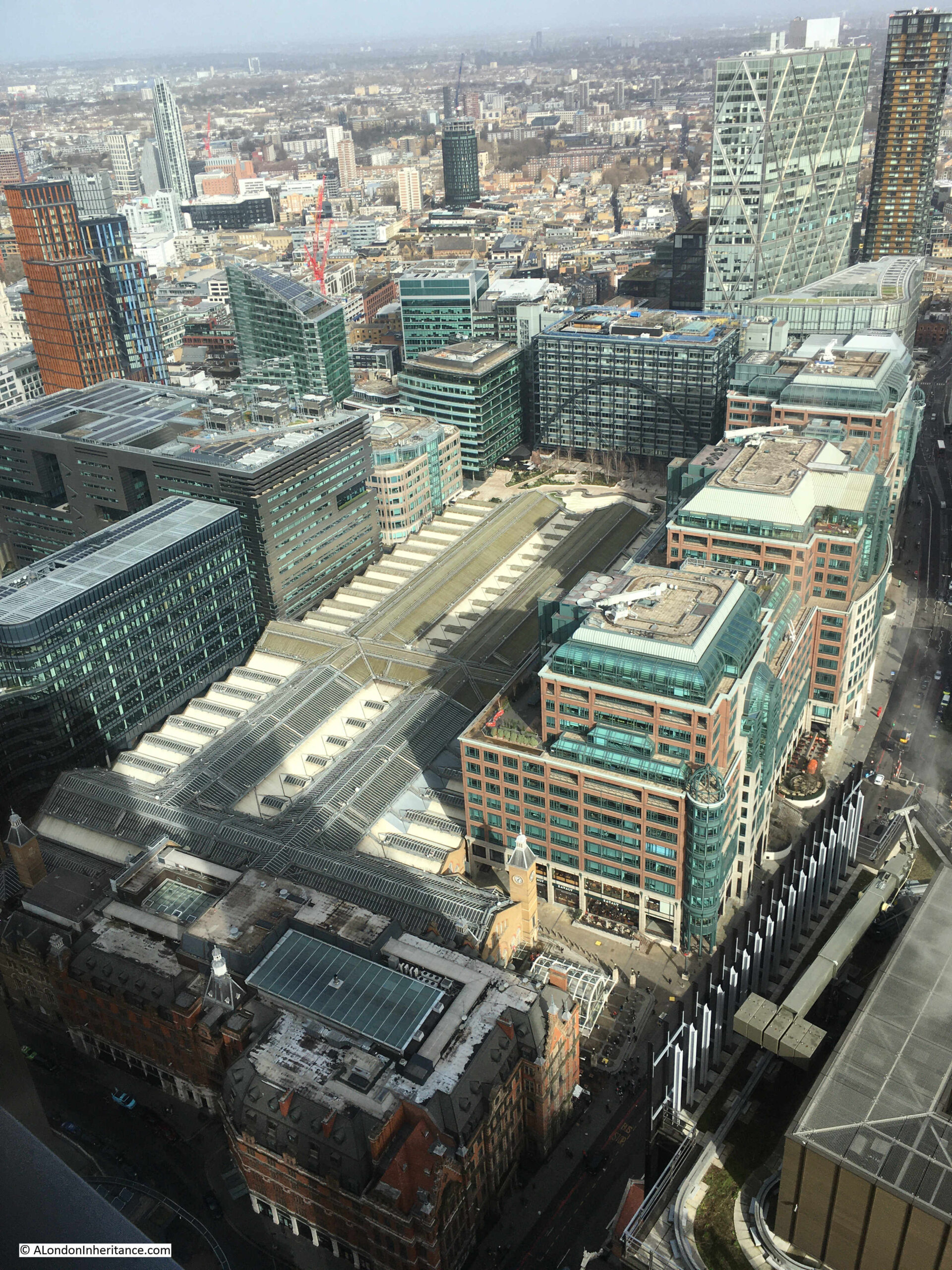
The main buildings of the station can be seen in the lower left corner, with the roof over the main concourse at ninety degrees to the roof over the platform which runs up towards the right.
To the left of the station is the Broadgate development which was constructed on the site of Broad Street Station. On the right of the station, large office blocks have been built between the station roof and Bishopsgate. Some of the Liverpool Street platforms extend under these new office blocks.
The roof of the station appears relatively low compared to the surrounding buildings and ground level, again showing that the platforms of the station are below ground level.
In the above photo, and the photo below, at the upper end of the station roof, there is an office block which has an arch running across the façade, and there is an open space between the office block and the end of the station roof.
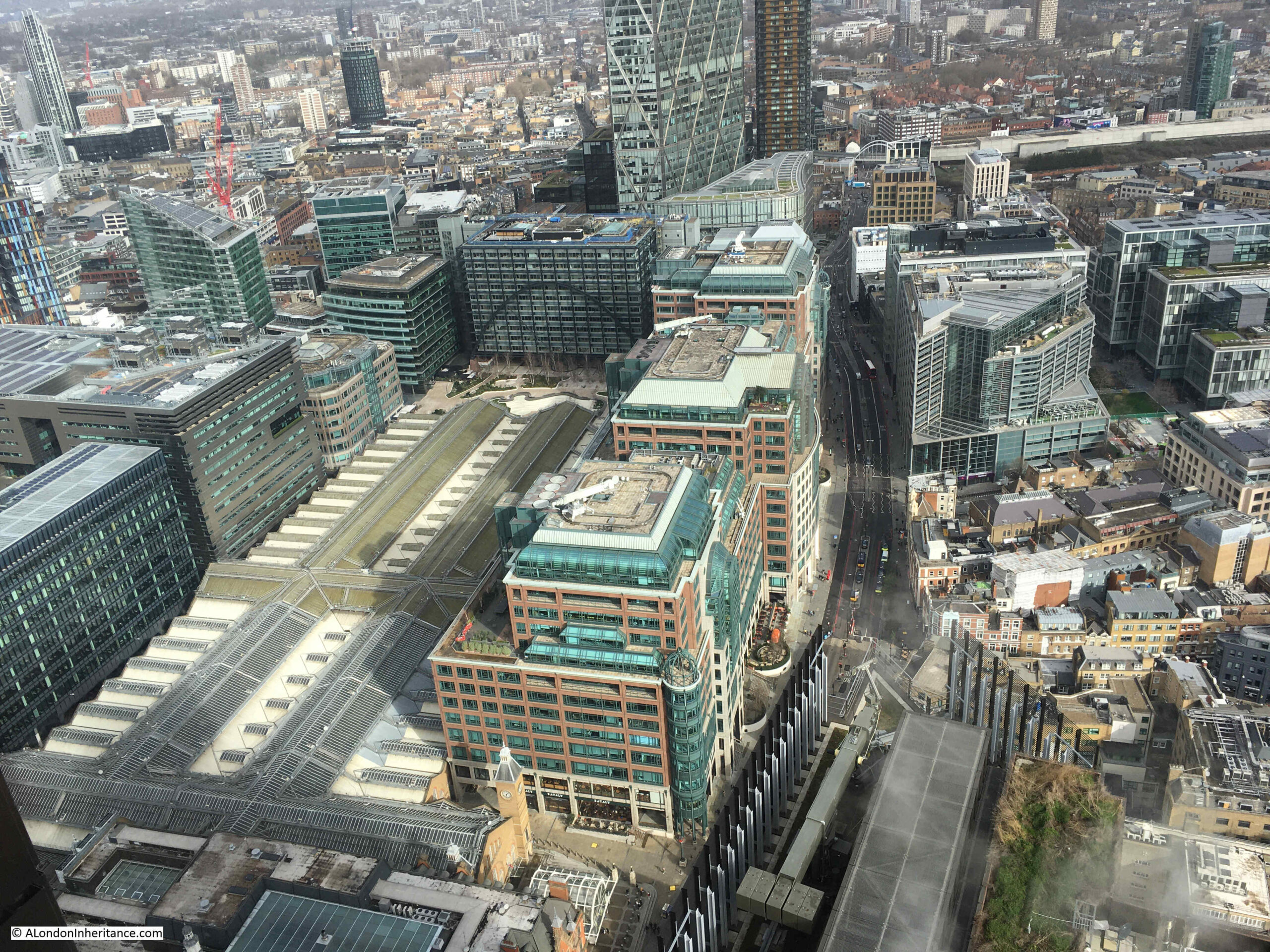
The open space is Exchange Square which has recently reopened after a redevelopment, and it is from here that I can get a similar photo to my father’s:
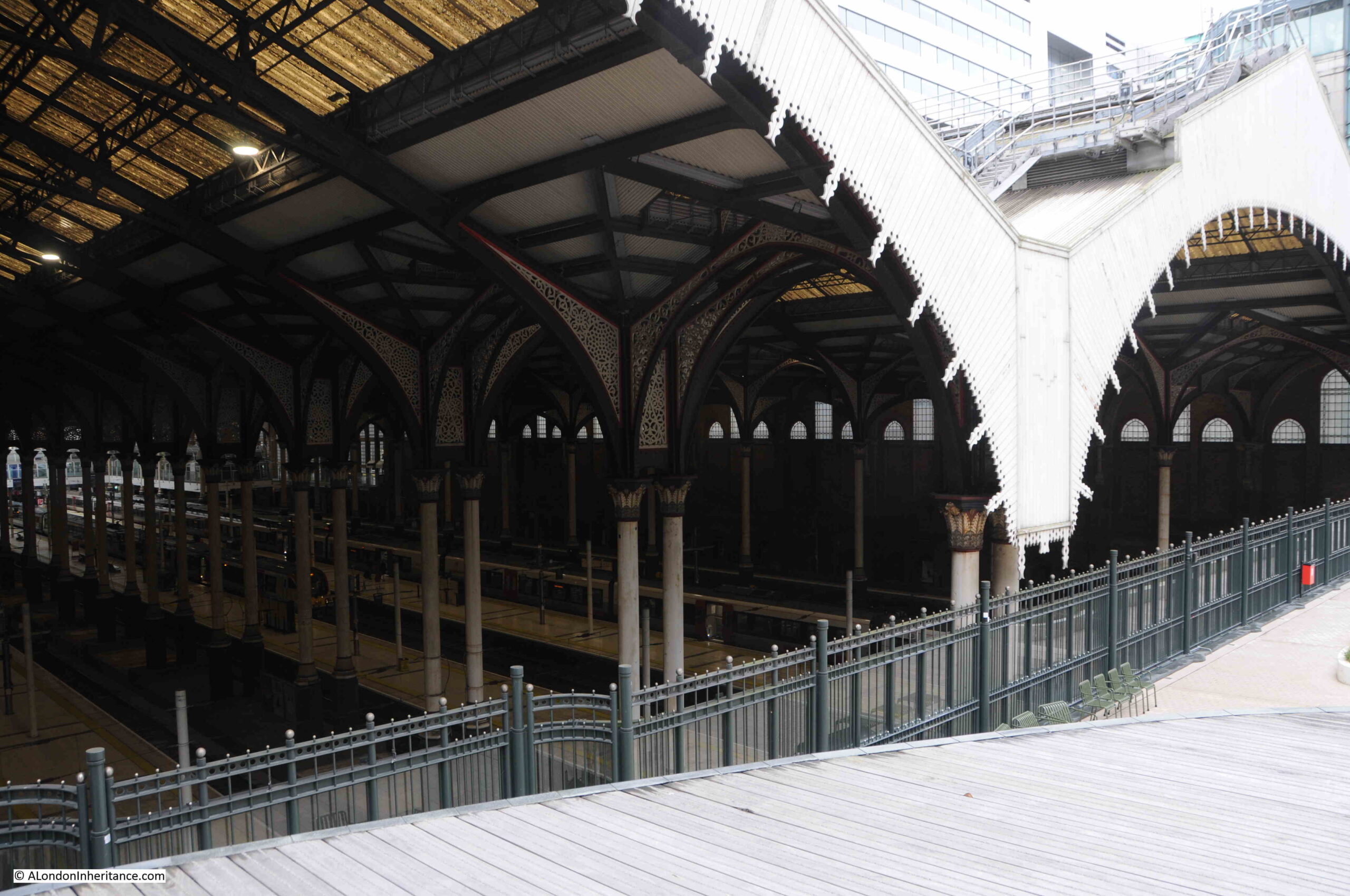
The photo is far closer to the end of the roof over the station platforms than my father’s, and I will explain why shortly. To help confirm that my father’s photo is of Liverpool Street Station, the pattern around the edge of the wooden roof is the same, as are the windows in the brick walls on the far side of both photos.
Exchange Square is a remarkable open space. As can be seen from the above photo, the edge of the space is up against the roof over the station, and from here you can look down directly into the station:
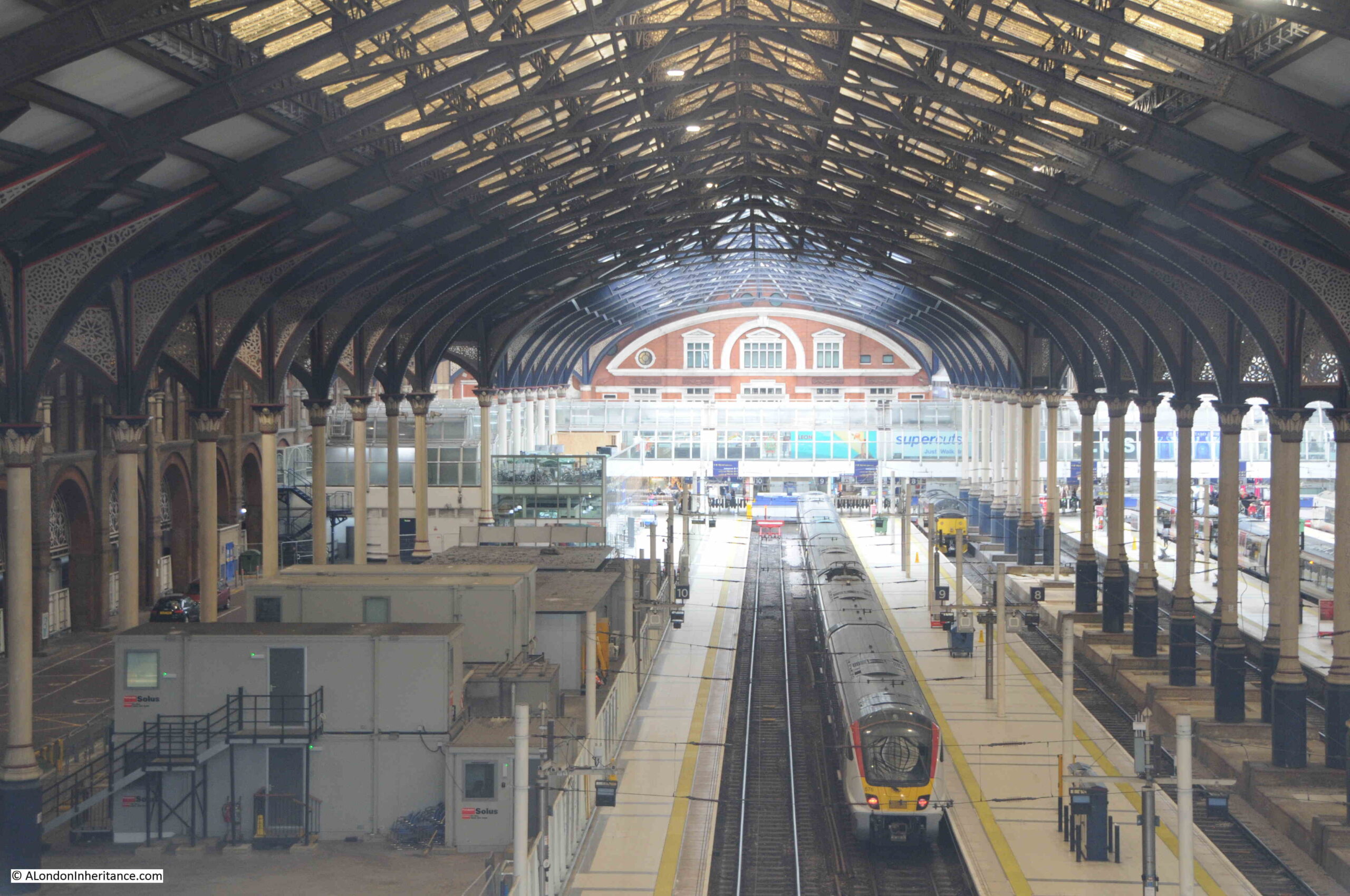
The roof almost comes down to the point where you can stand on the chairs and touch the wooden decoration (you cannot, it is just too high, and the wandering security man would not be very happy if you tried).
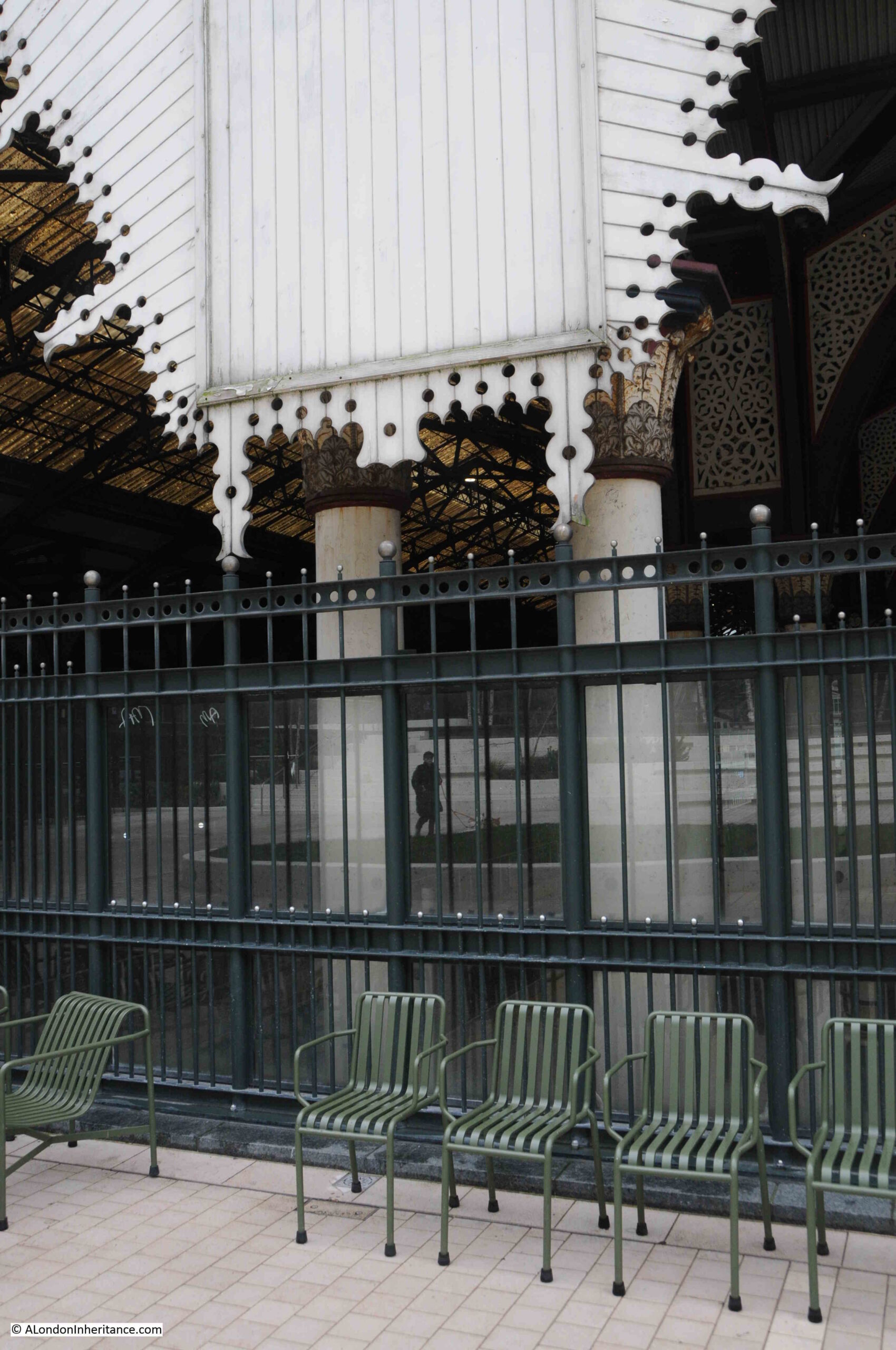
You can get a good view of the decoration at the top of the columns supporting the roof:
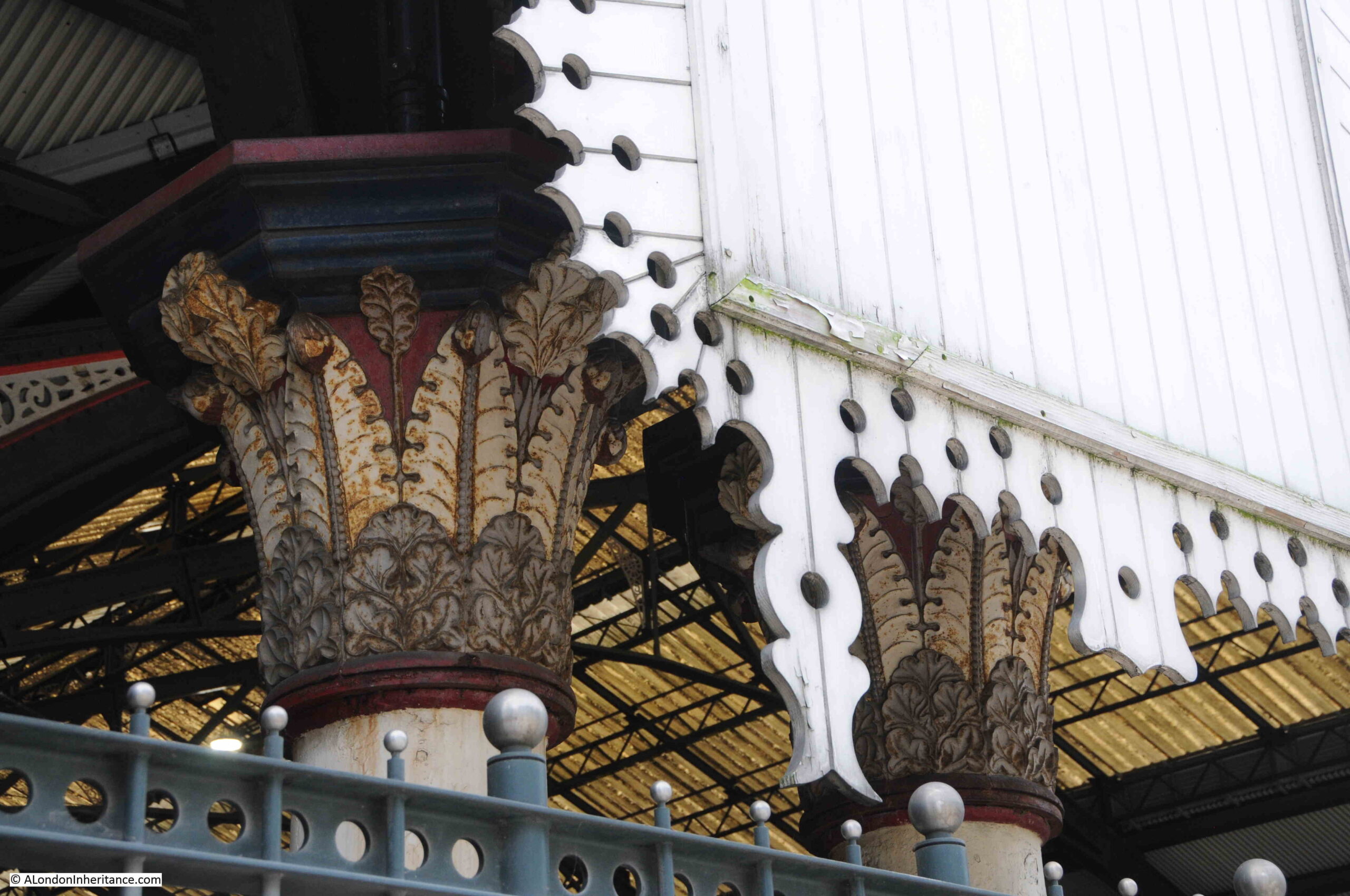
Details of the roof:
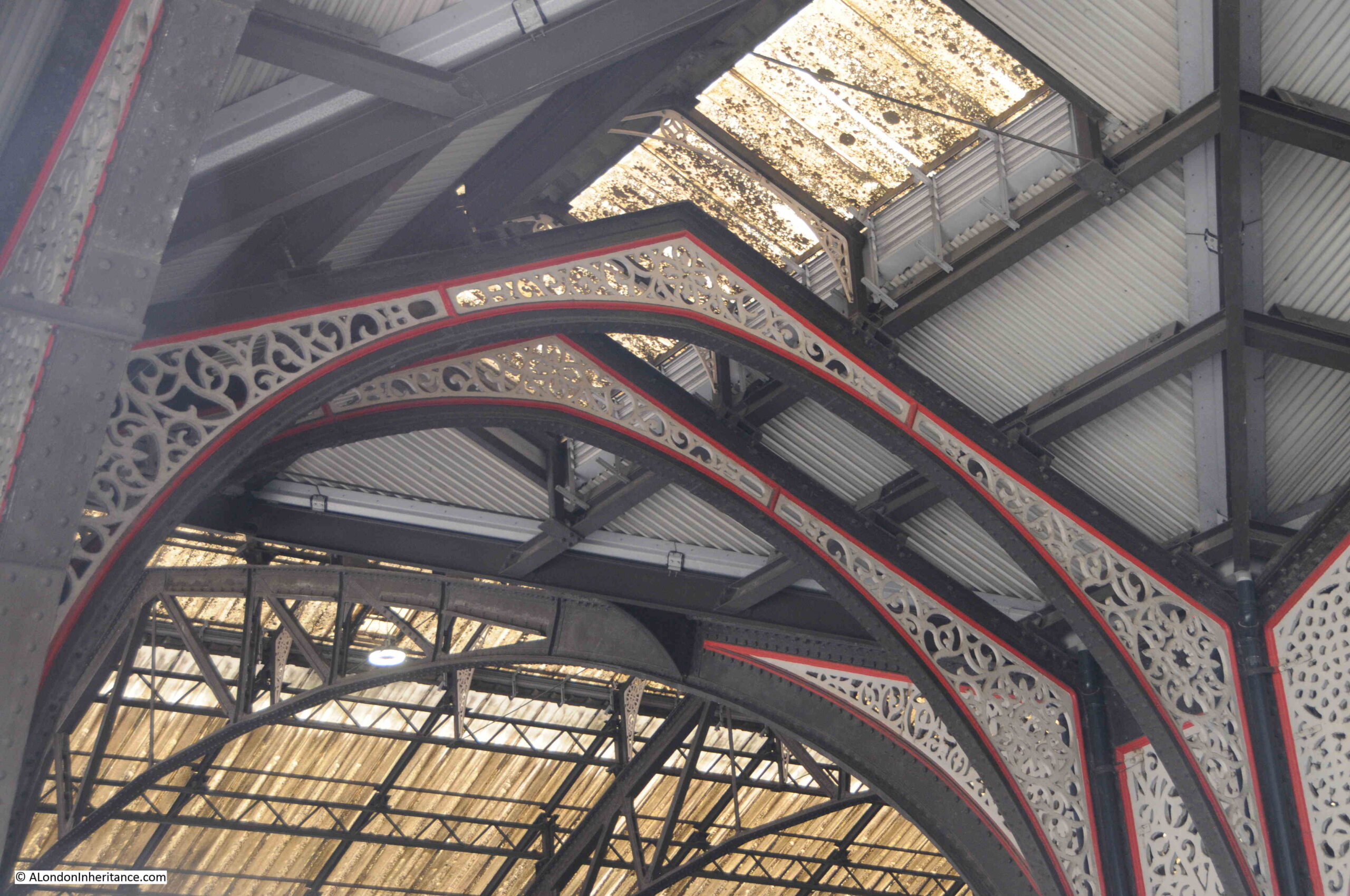
And the roof stretching over the platforms:

The view from Heron Tower shows that the roof over the concourse and part of the platforms closest to the concourse appear to be cleaned, whilst the roof over the main part of the platforms is dirty as shown in the above photo.
I assume this is to save money by only cleaning the roof over the area where people wait for their train, however it is probably my 1970s first experiences of London, but I like the dirty roof – a city can be too clean.
View from the corner of Exchange Square, with the roof of Liverpool Street Station with the two central arches, and smaller flat roof / arches at the sides, with the towers of the City in the background.
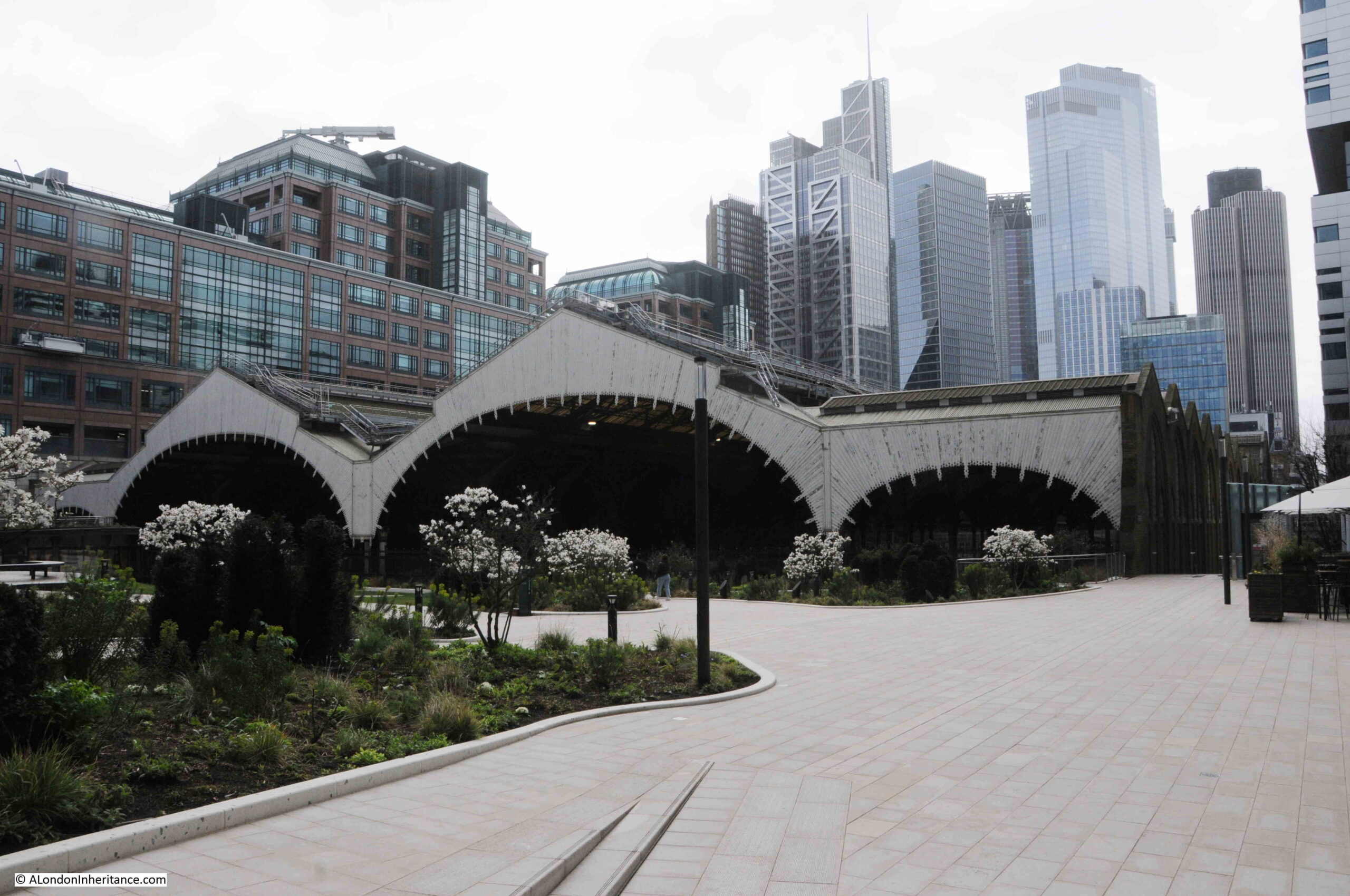
Although Exchange Square has recently reopened, it has long been part of the original Broadgate development, which included a number of works of art, two of which can be seen in Exchange Square.
This is the Broadgate Venus – a 5 tonne patinated bronze, created for Broadgate in 1989 by the Columbia artist and sculptor Fernando Botero:
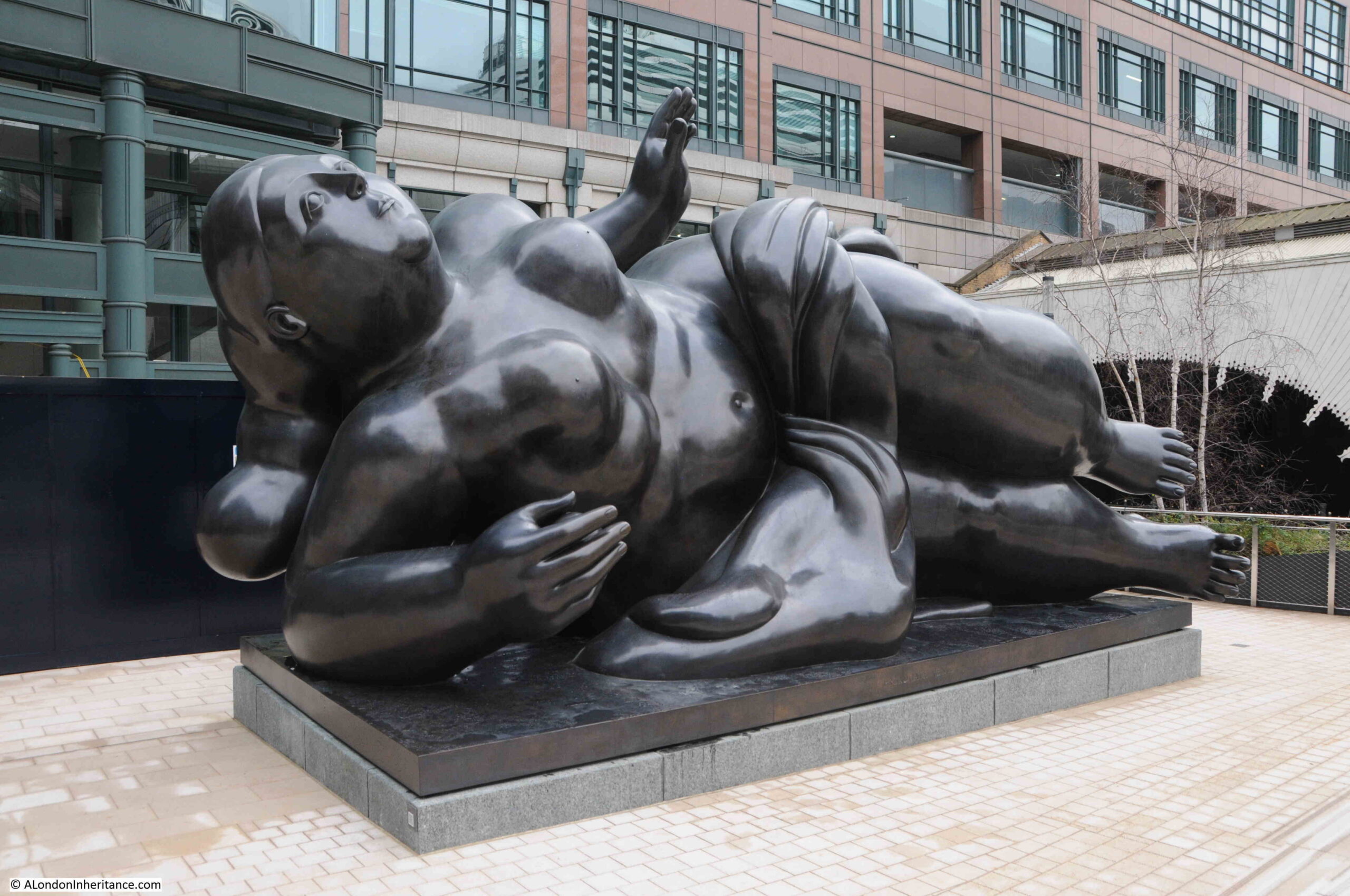
Towards the back of Exchange Square is this group of figures, who look as if they have been wrapped up against the cold of a March day:
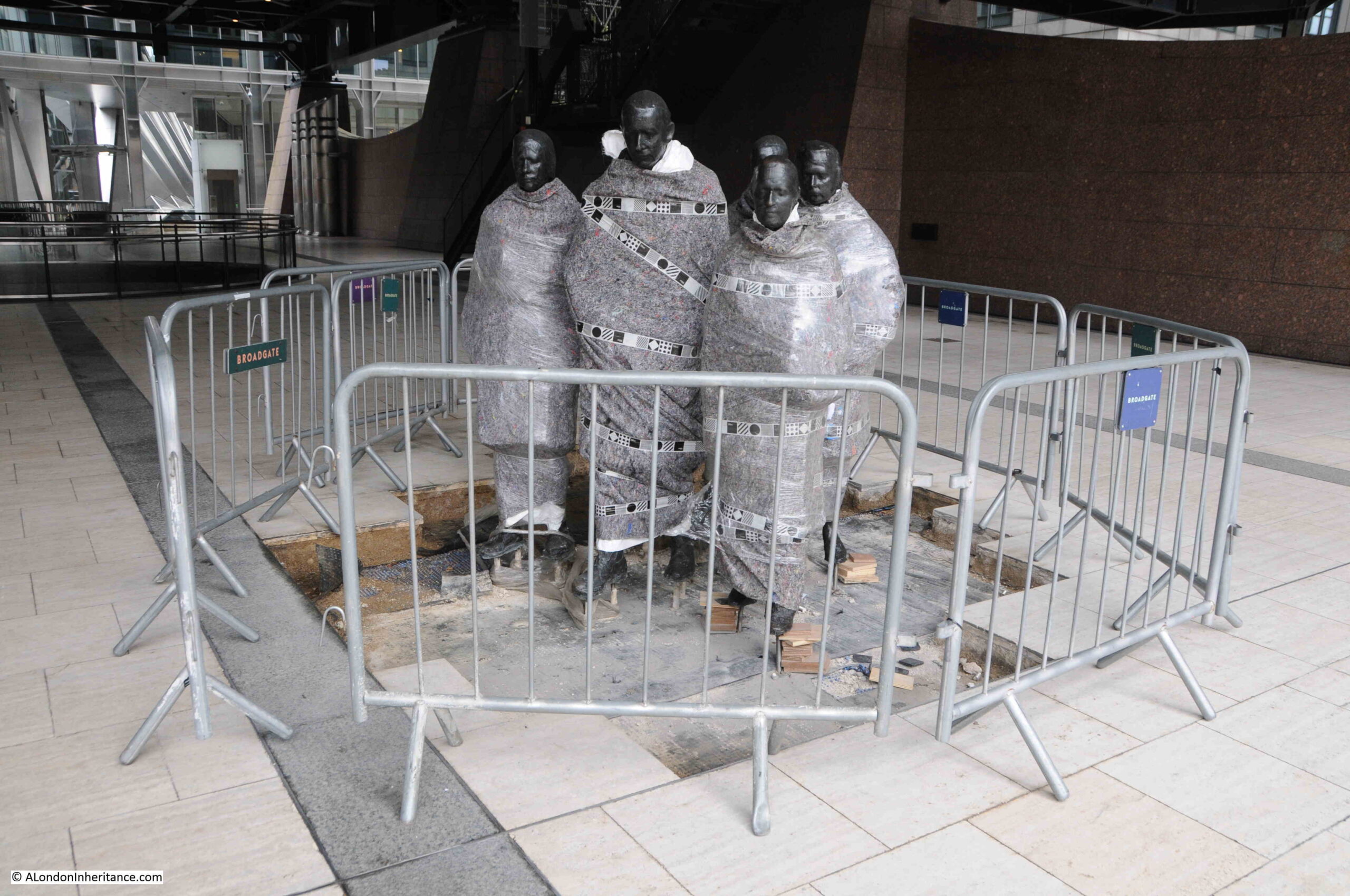
The group is a work titled “Rush Hour” by the American artist George Segal and was created in 1982. The work has only recently returned to Broadgate after being stored off site during Exchange Square’s renovation. Hopefully the weather will have warmed up by the time they are unwrapped.
But what of the two streets carried by bridges over the tracks into Liverpool Street Station?
Firstly these are old streets. I have highlighted Primrose Street (yellow oval) and Pindar Street (which was originally Skinners Street – red oval) in the following extract from Rocque’s 1746 map of London:
The map shows the dense network of streets, yards, courts and alleys that were lost when Liverpool Street Station was built.
Primrose and Pindar Street’s remained, but were turned into bridges that ran over the railway, rather than a street with buildings alongside.
Pindar Street disappeared with the building of Broadgate, however Primrose Street does remain, linking Bishopsgate and Appold Street. The following view is looking west along Primrose Street:
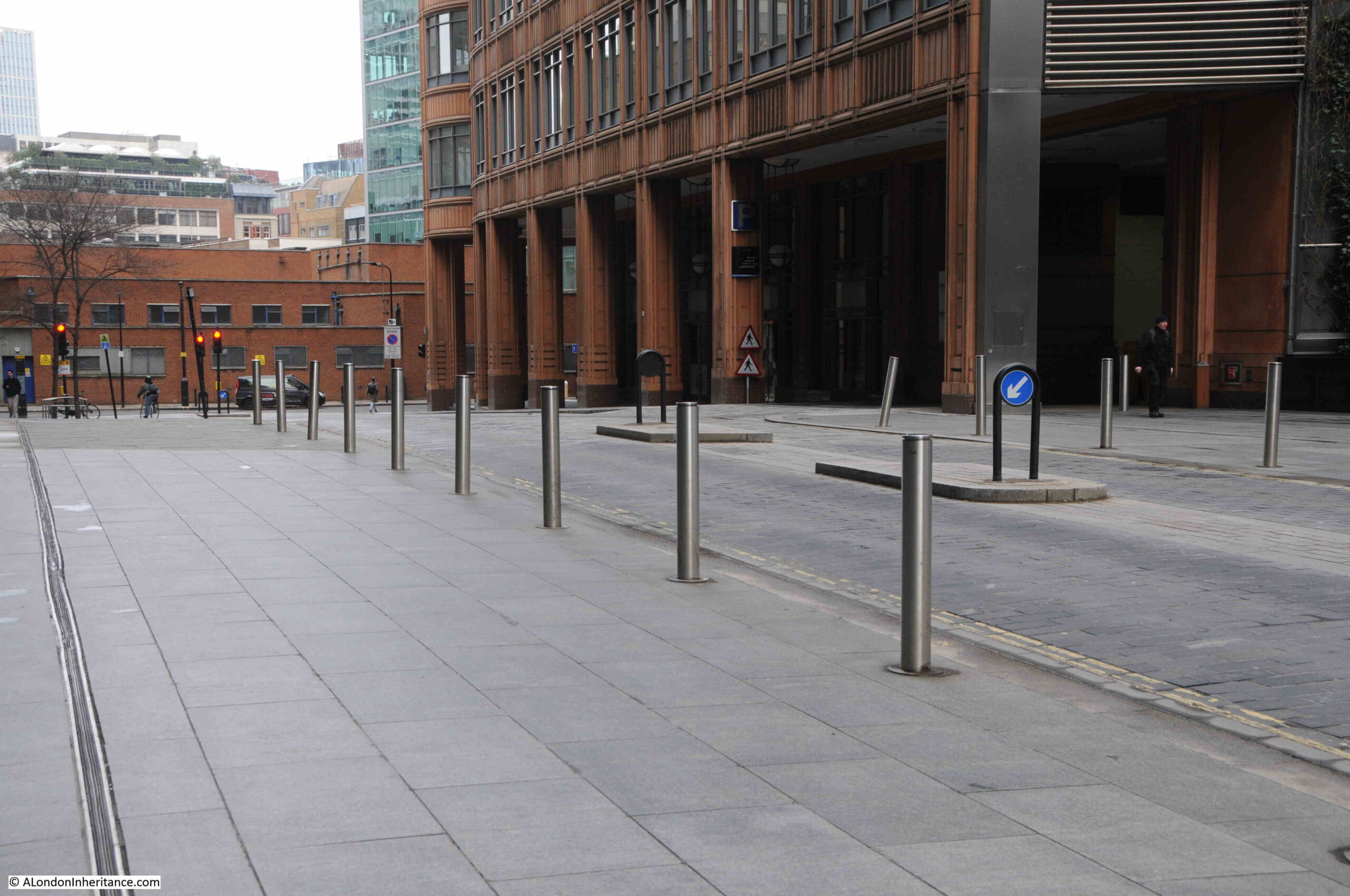
It does not look as if you are standing over a large number of rail tracks as there are office blocks on either side of the street, however a couple of things show the true nature of the street.
On the left of the above photo, an expansion gap can be seen running the length of the street, between the paving slabs. This shows that the road is still carried over on a bridge like structure, which can expand at a different rate to the slabs carrying the office blocks on either side.
Also in the above photo, and the following photo which is looking towards Bishopsgate, the road dips at the far end of Primrose Street, rising to the canter as it passes over the tracks.
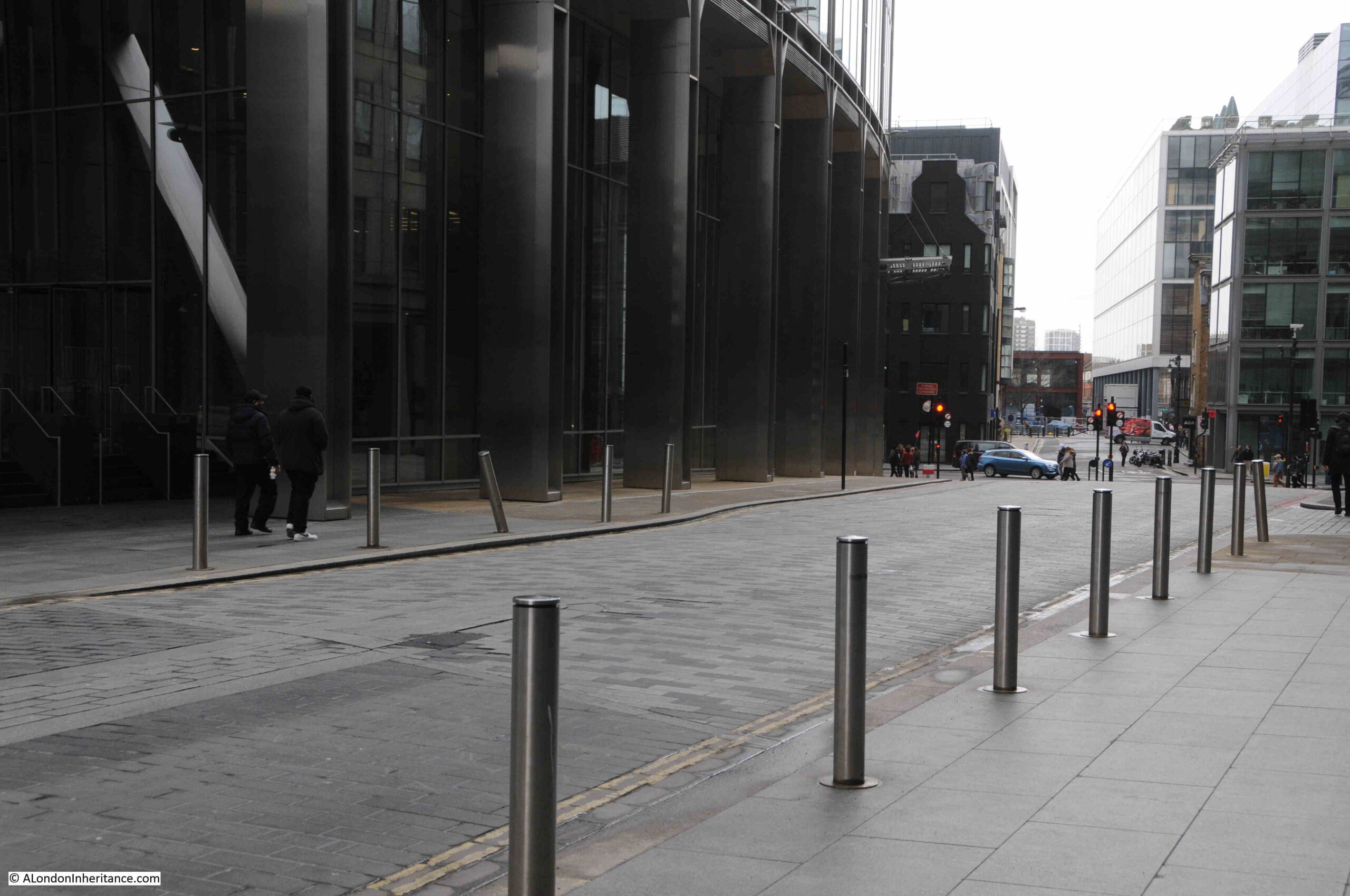
The following photo is looking from Primrose in towards Exchange Square, with part of the roof of Liverpool Street Station just visible. Exchange House is between Exchange Square and Primrose Street:
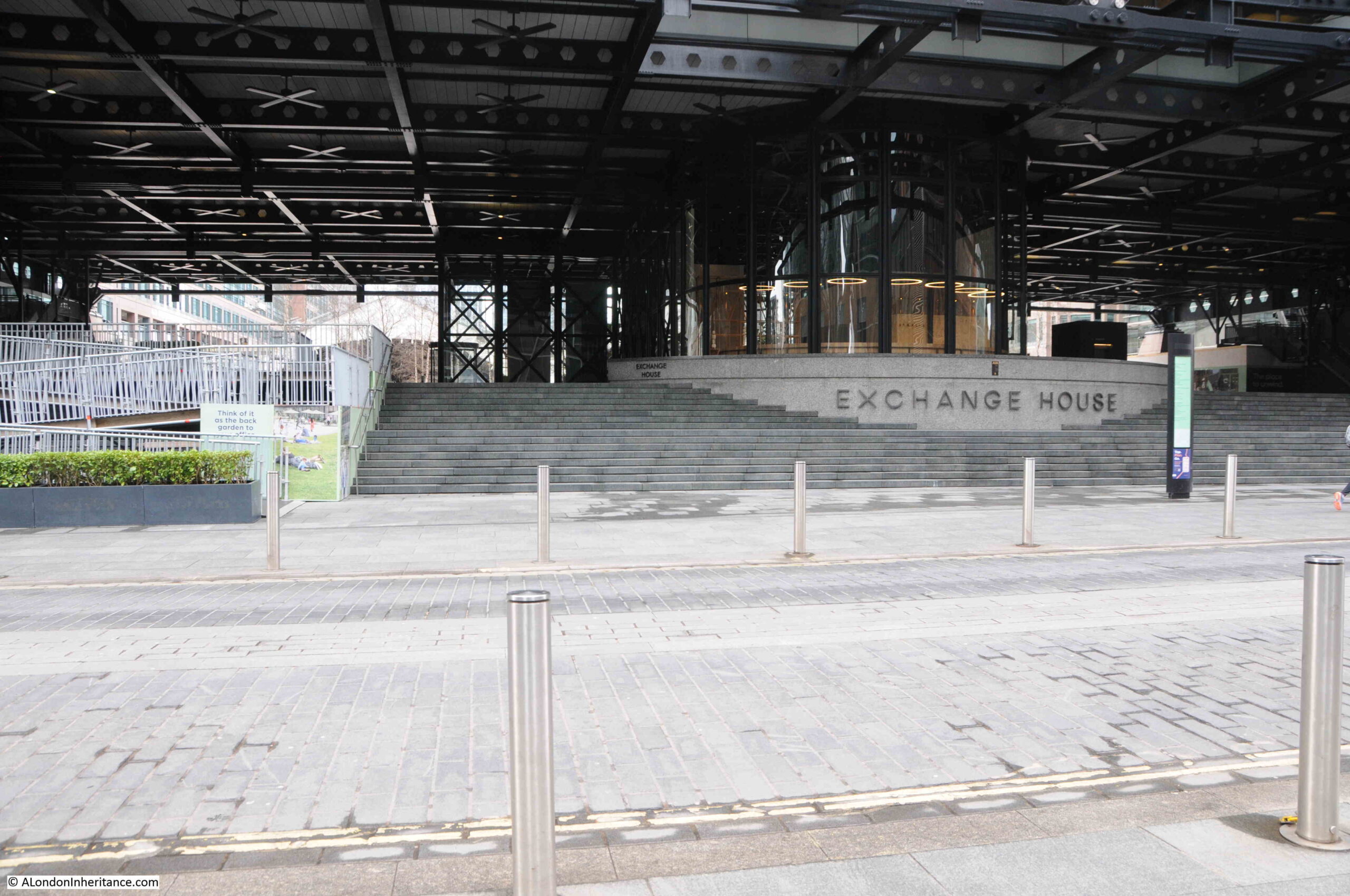
The bridge carrying Pindar Street was lost during the redevelopment of the area. The following photo is from under Exchange House looking towards the station. Pindar Street ran from left to right between the trees and seats, and just in front of where I was standing.
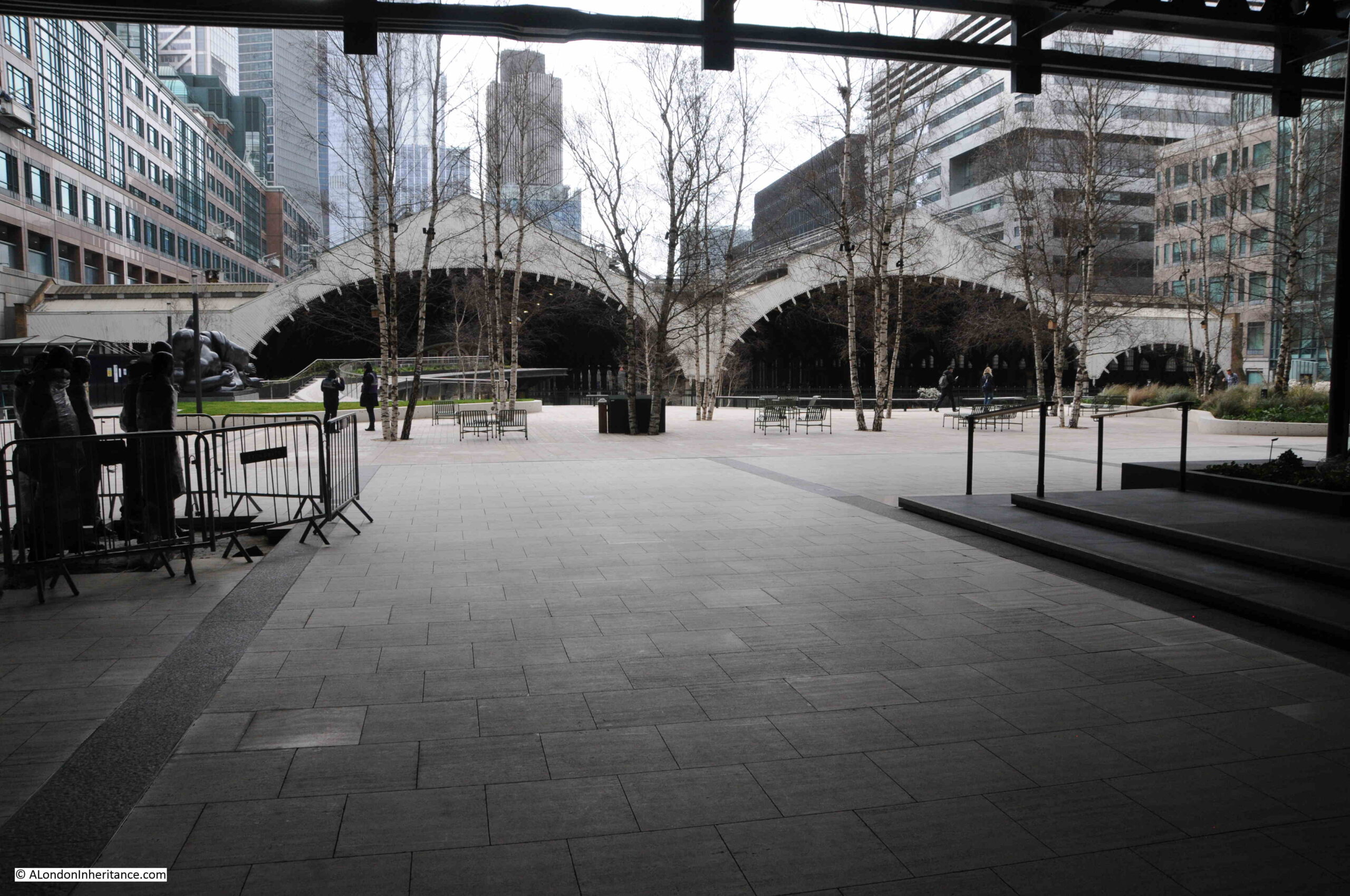
I suspect that my father was standing in the centre of the line of trees to take the photo at the top of the post, looking towards the right, to get the right-hand main arch of the roof, and part of the smaller arch on the right into the photo.
Exchange House is an interesting office block. Straddling the main rail tracks into Liverpool Street Station required some interesting construction techniques to be used. This is the building that can be seen from the Heron Tower with the metal arch crossing the façade of the building.
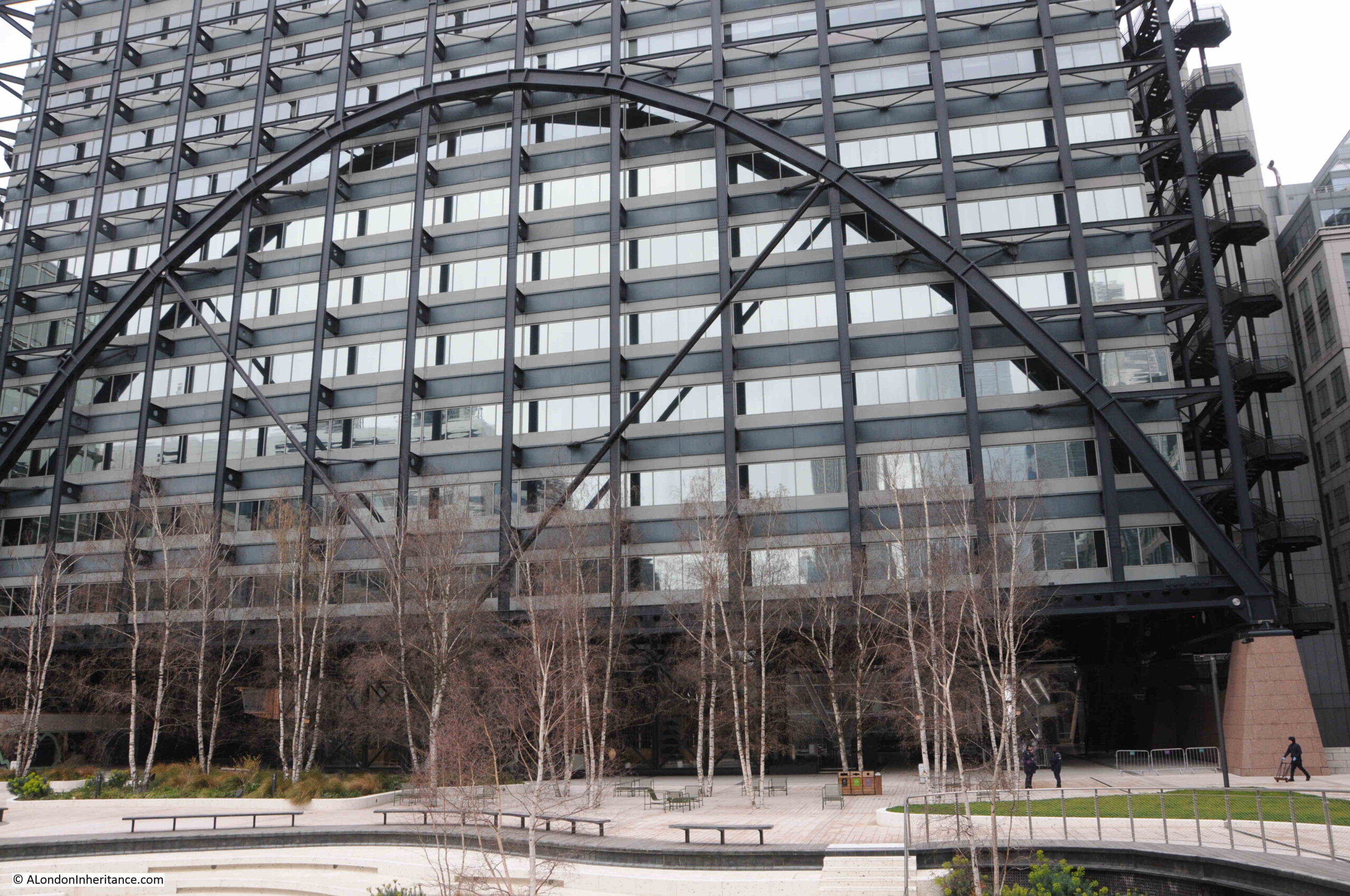
As the rail tracks are below Exchange House, it was not possible to put large amount of piling down to support the building, so much of the weight is supported on either side, where a supporting structure can be built down to ground level to the side of the rail tracks.
The metal arch is used to transfer some of this weight to the supporting structure, one side of which can be seen in the above photo to the right of the building.
View of the redeveloped Exchange Square:
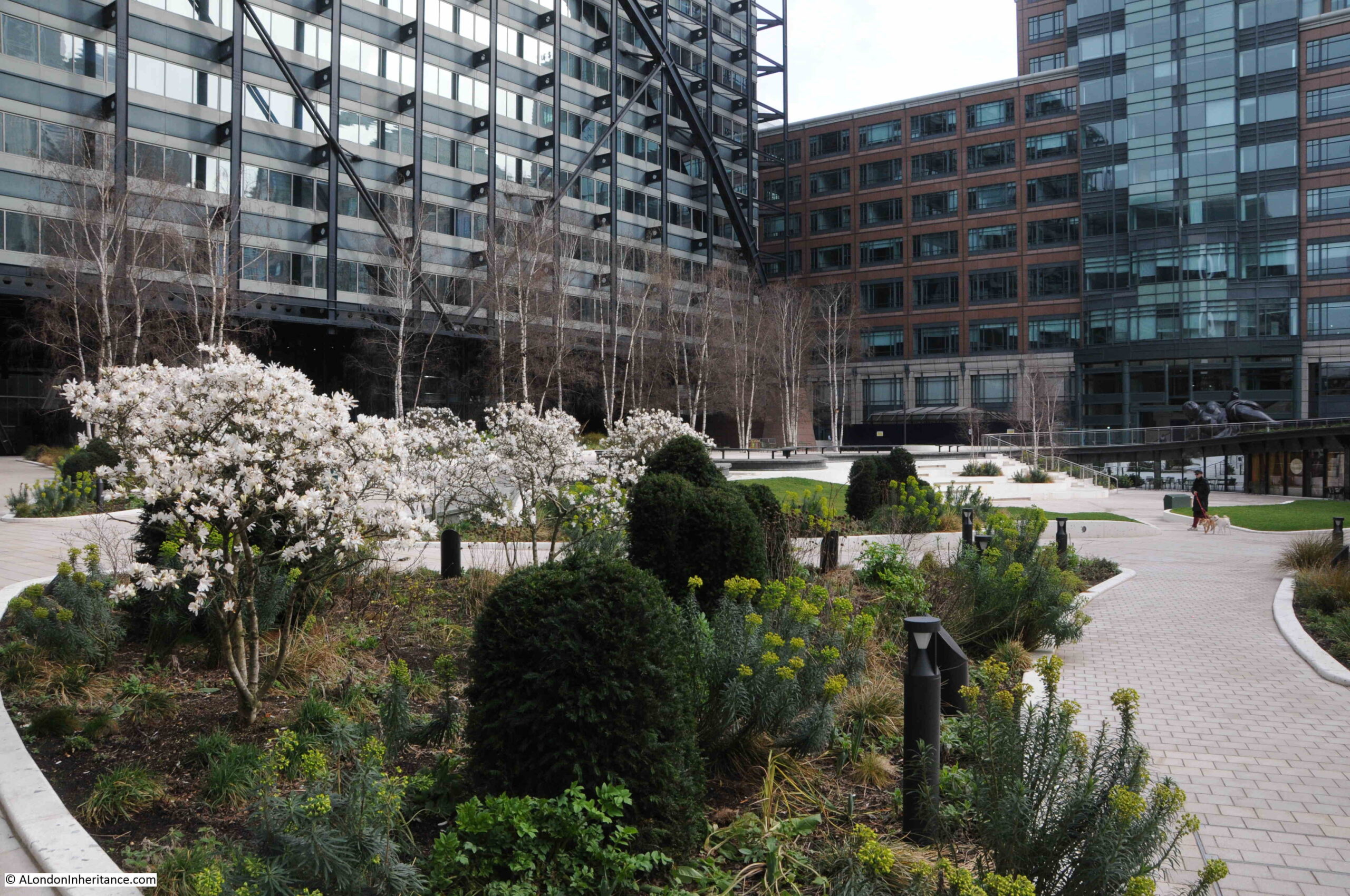
The architect for the redeveloped Exchange Square was the DSDHA architecture, urban design and research studio, and the project has been shortlisted for the RIBA London Award 2023.
I am not usually a fan of these small open spaces, which often come with a description by landowners and architects which far exceeds real experience of the space, however I really do like Exchange Square.
The space slopes towards the station, drawing the eye to the large sheds over the station platforms and tracks. There is a fair amount of planting, however a chilly and overcast Saturday in March was probably not the best time of year to view the planting and it will no doubt be better when established, and with better weather.
It was also really quiet when we were exploring the area. Only a dog walker and a security guard were walking through the square. Again, it is probably far busier in the week, rather than at the weekend.
Access to Exchange Square is not that obvious. There is access from Primrose Street (under Exchange House), and up some steps from Appold Street.
Access from Liverpool Street is along the side of the station. On the south eastern side, to the right of the escalators down to the concourse, there is a walkway which goes through the edge of the office blocks between the station and Bishopsgate.
From the south western side of the station, there is an open walkway which runs along the side of the station wall. This is the view along the walkway from Exchange Square.
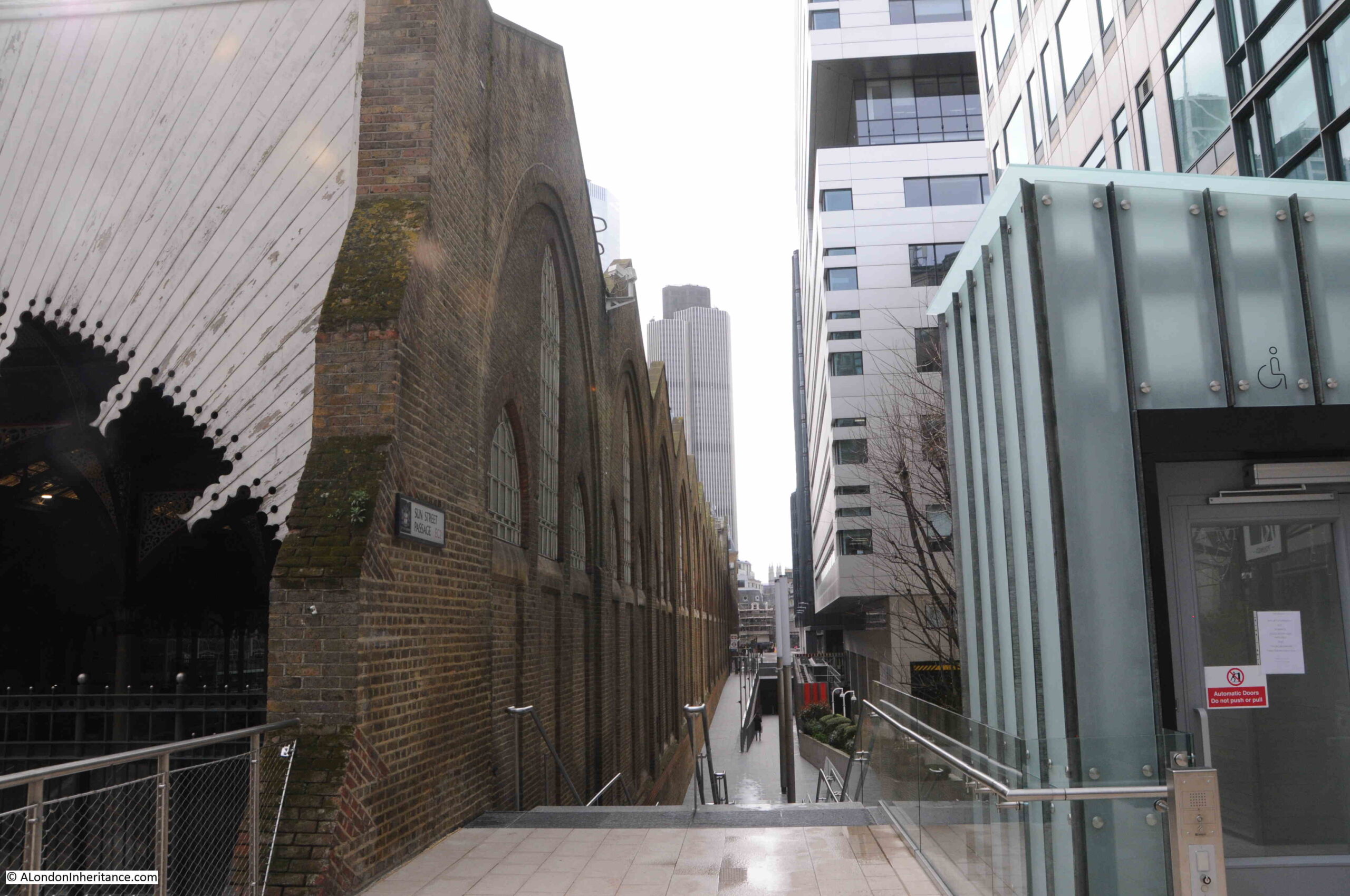
The name of the walkway is Sun Street Passage. The name recalls one of the streets that was lost when Liverpool Street Station was built. There was a Sun Street, which I have highlighted in the following 1746 map, which ran across the station, under the current location of the platforms.
We walked along Sun Street Passage, with the high brick walls of the station on the left, and half way down there is an entrance into the station:
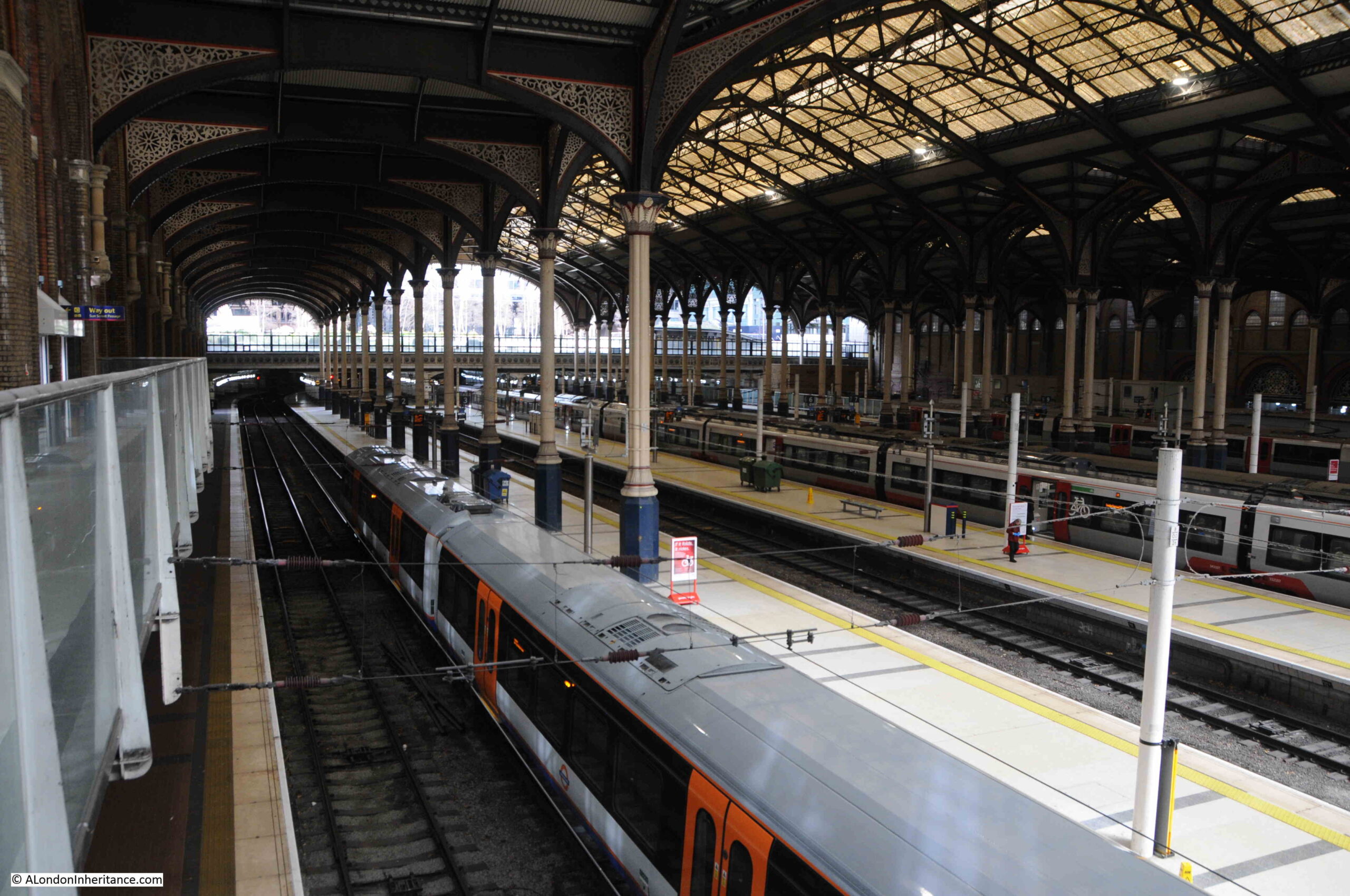
The above view is looking towards Exchange Square, which you can just see running across and above the platforms.
The concourse, where the roof runs at a ninety degree angle to the roof over the platforms, and with cleaned glass that allows a large amount of natural light to the area below:
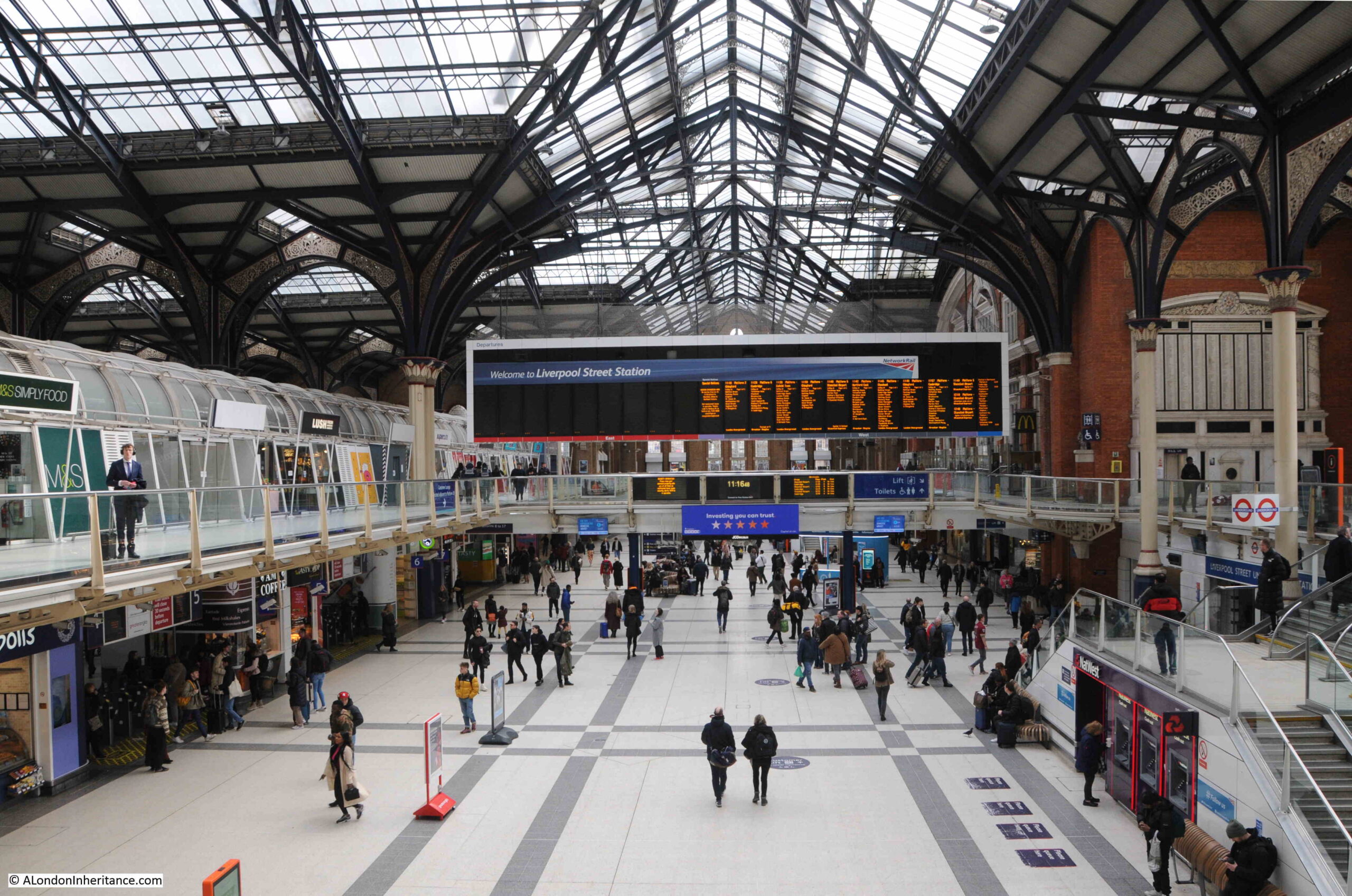
The station is so very different to when I used it every day during the 1980s. Much cleaner, the old destination indicators above the entrance to the platforms, where tickets where inspected manually, and always busy in the morning and evening commute, less so late in the evening when the pubs closed.
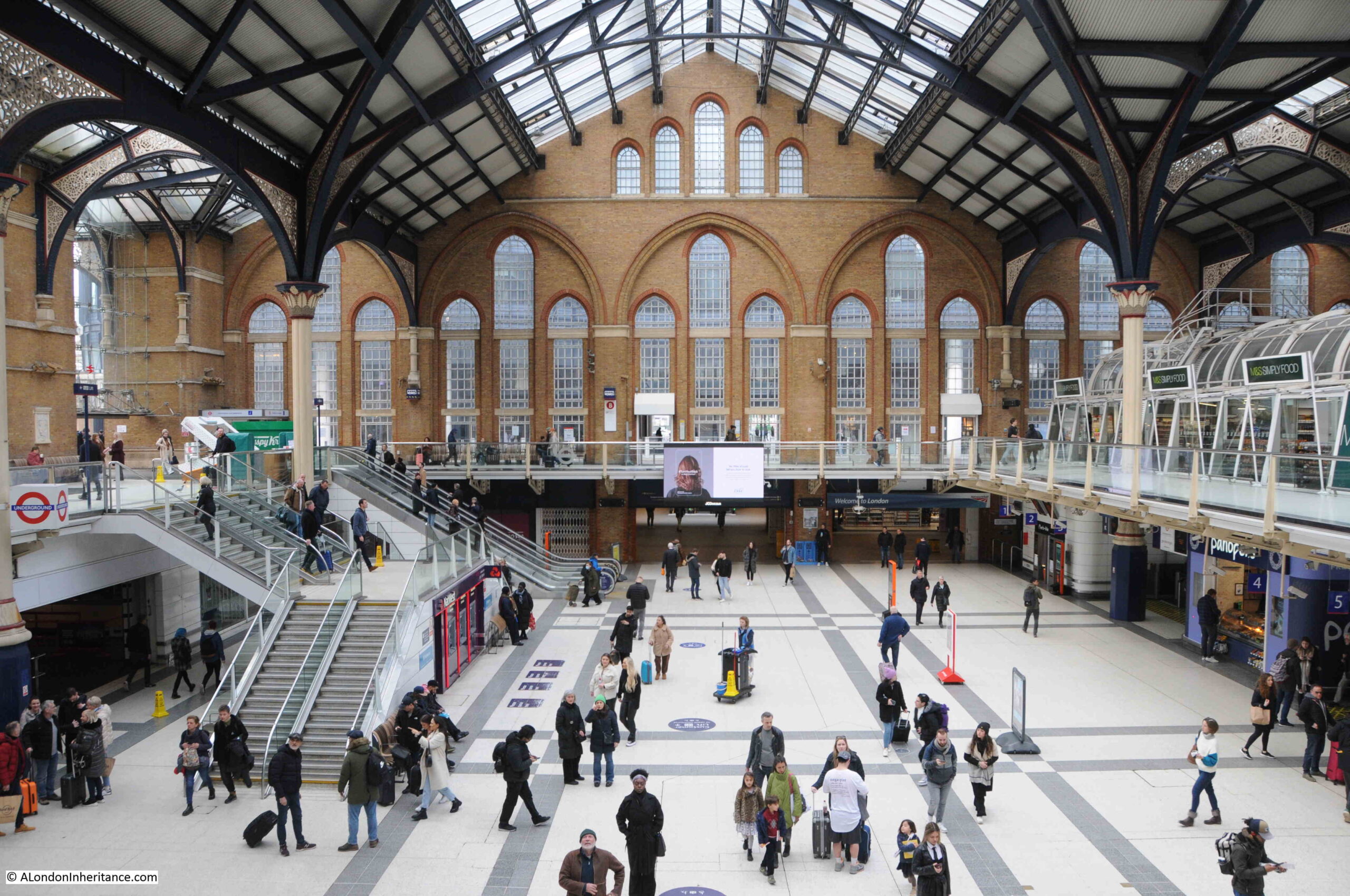
The above photo is from a walkway that crosses the centre of the station. This is looking towards where there was a cut through to Broad Street Station. On the left are the stairs running up to the exit to Liverpool Street (the street after which the station is named).
The following photo is looking in the opposite direction. At the far end there are stairs and escalator up to Bishopsgate. Both views again show that the concourse and platforms are below ground level.
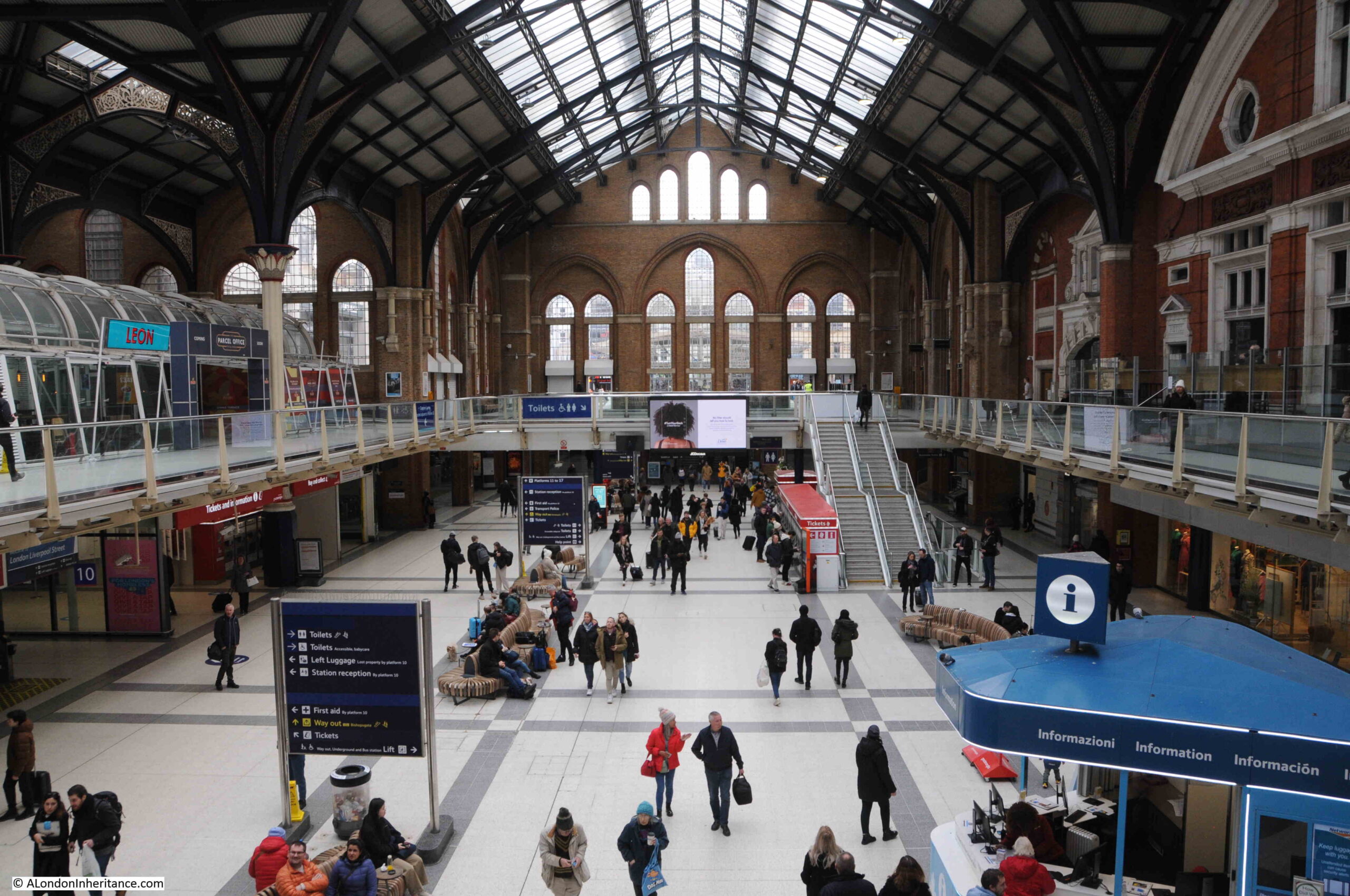
In the entrance space from Liverpool Street is the bronze sculpture “Kindertransport – The Arrival”, by Frank Meisler, which was installed in 2006:
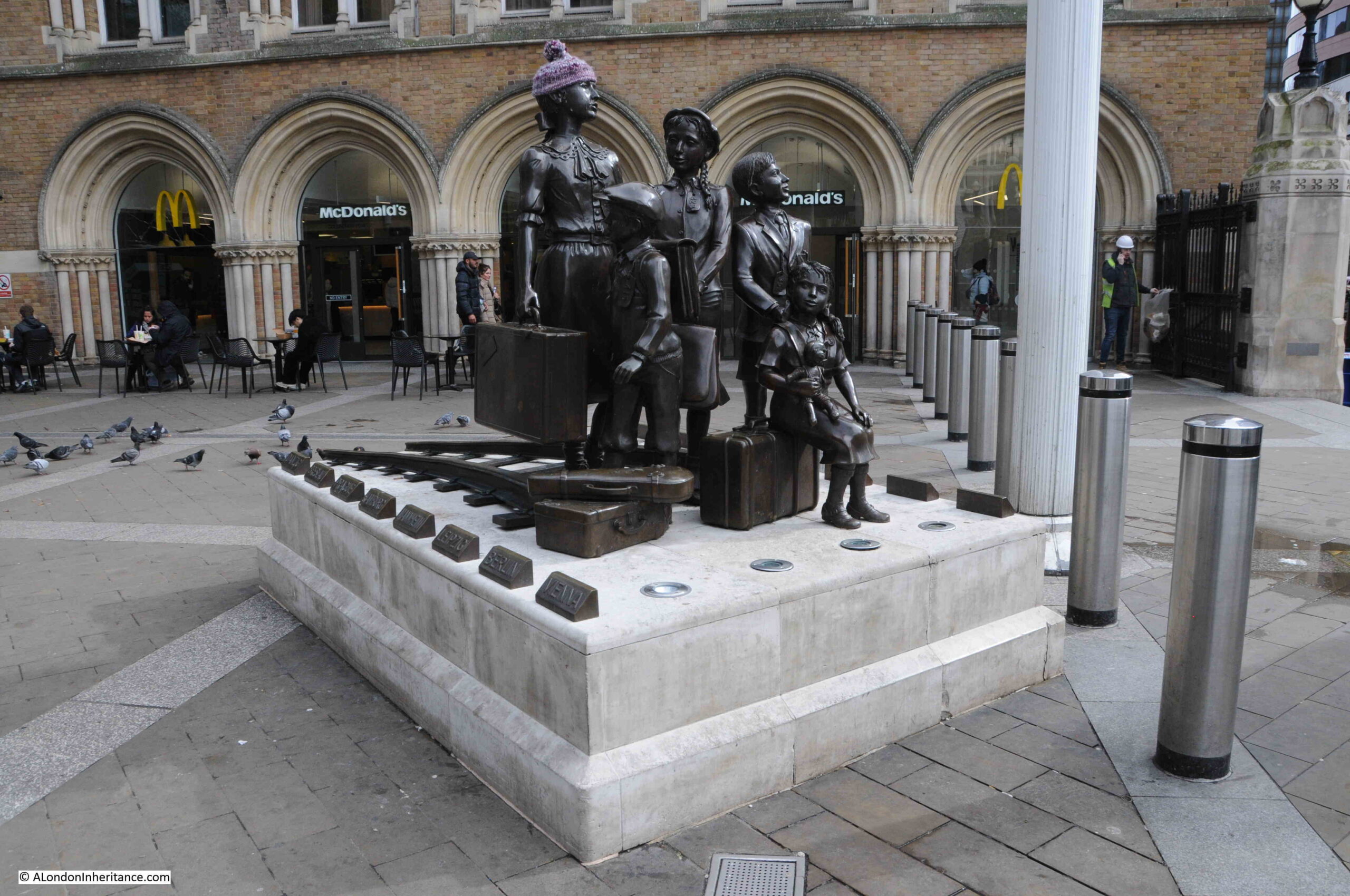
The memorial is to the almost 10,000 children who escaped Germany between 1938 and 1939, travelling by boat from the Hook of Holland in the Netherlands to Harwich, then by train from Harwich to Liverpool Street.
The following view is looking along Liverpool Street with the station buildings on the left:
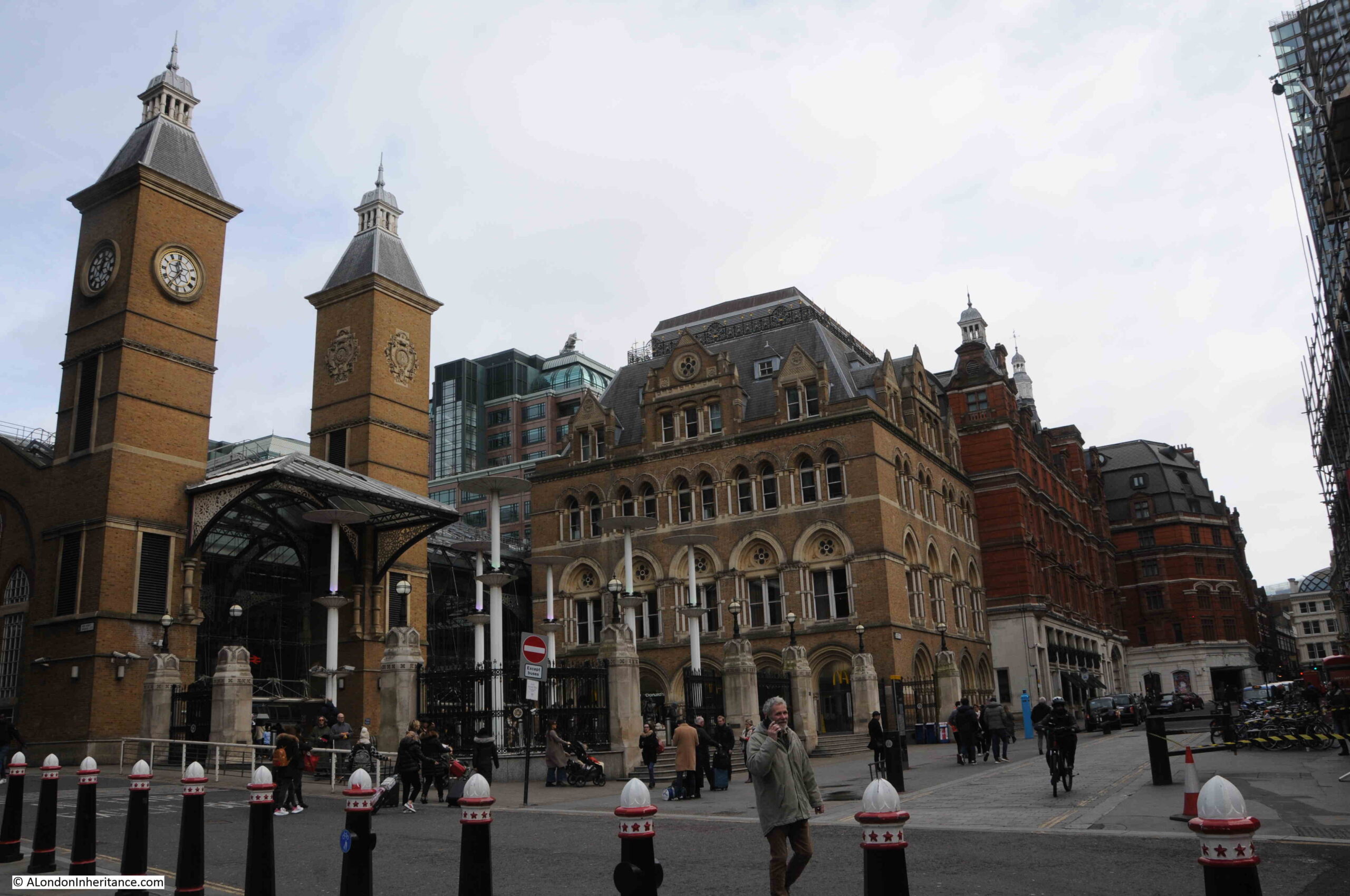
The two towers to the left of the photo were part of the late 1980s redevelopment of the station. The area occupied by the towers was a ramp providing access down to the area between Liverpool and Broad Street stations.
There are currently proposals for a major redevelopment of the station, which will see the towers and the lighter brick building demolished, and two large towers built over the space and above the original station buildings and station hotel which is the of the darker red brick.
The proposals would completely overwhelm the original station buildings, and those supporting the development claim that it would encourage people to travel back to the City and would improve the experience of the station users.
I think that what users of the station would really prefer is a cost effective, efficient train service, rather than the redevelopment, with two large glass and steel towers built over the station buildings.
The Victorian Society have launched a campaign to save the station, with the rather brilliant slogan (if you have used London’s transport system) of “See It, Say It, Save It”
The Architects Journal have an overview of the proposals, here, and the Victorian Society campaign introduction is here.
View along the side of the station. Exchange Square is at the far end:

On the railings around the station entrance are the arms of the Great Eastern Railway, the original company that operated into Liverpool Street Station, with the individual arms of places served by the railway, including Essex, Norwich, Ipswich and Cambridge:
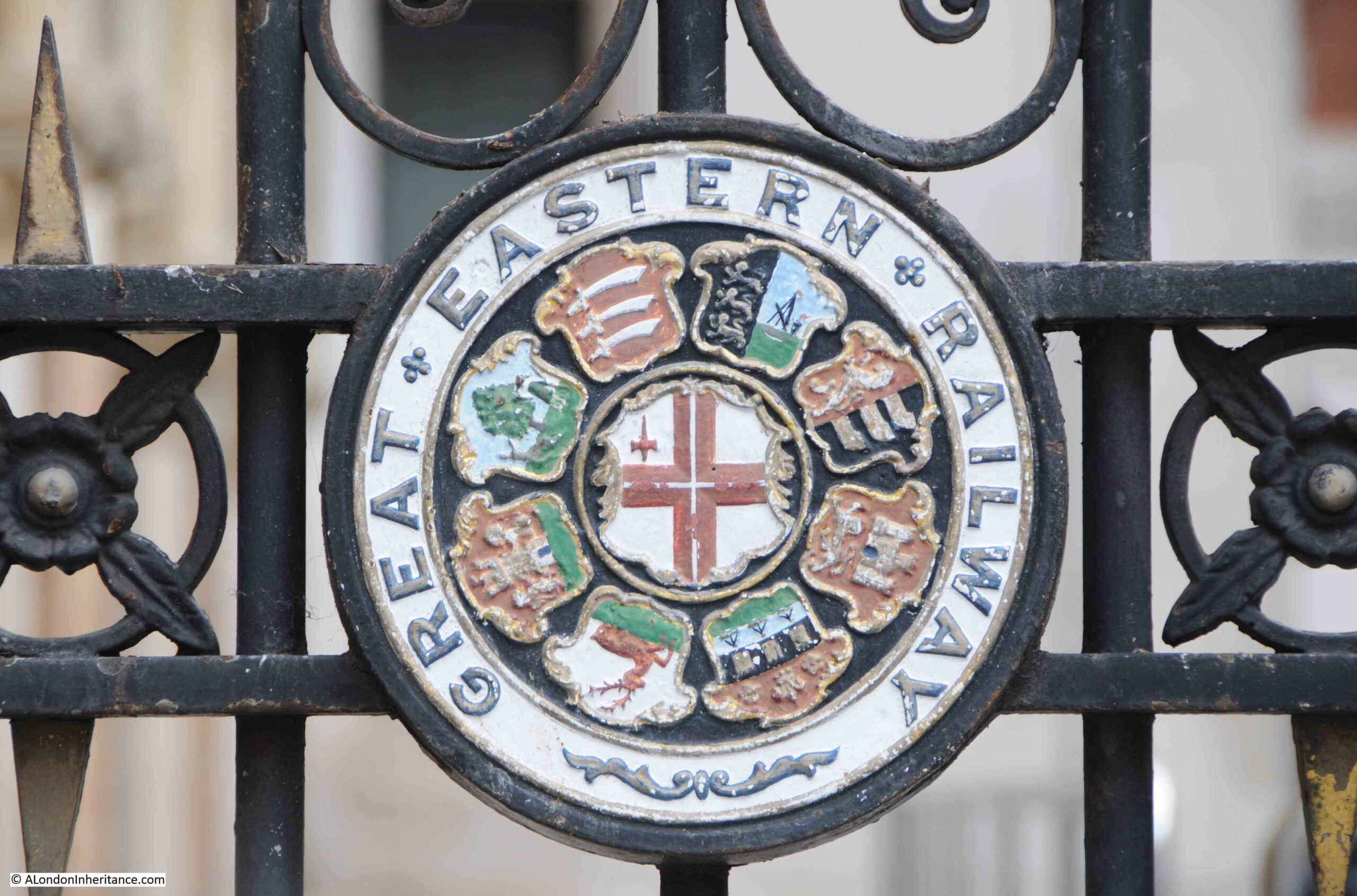
The station buildings on the corner of Liverpool Street and Bishopsgate:
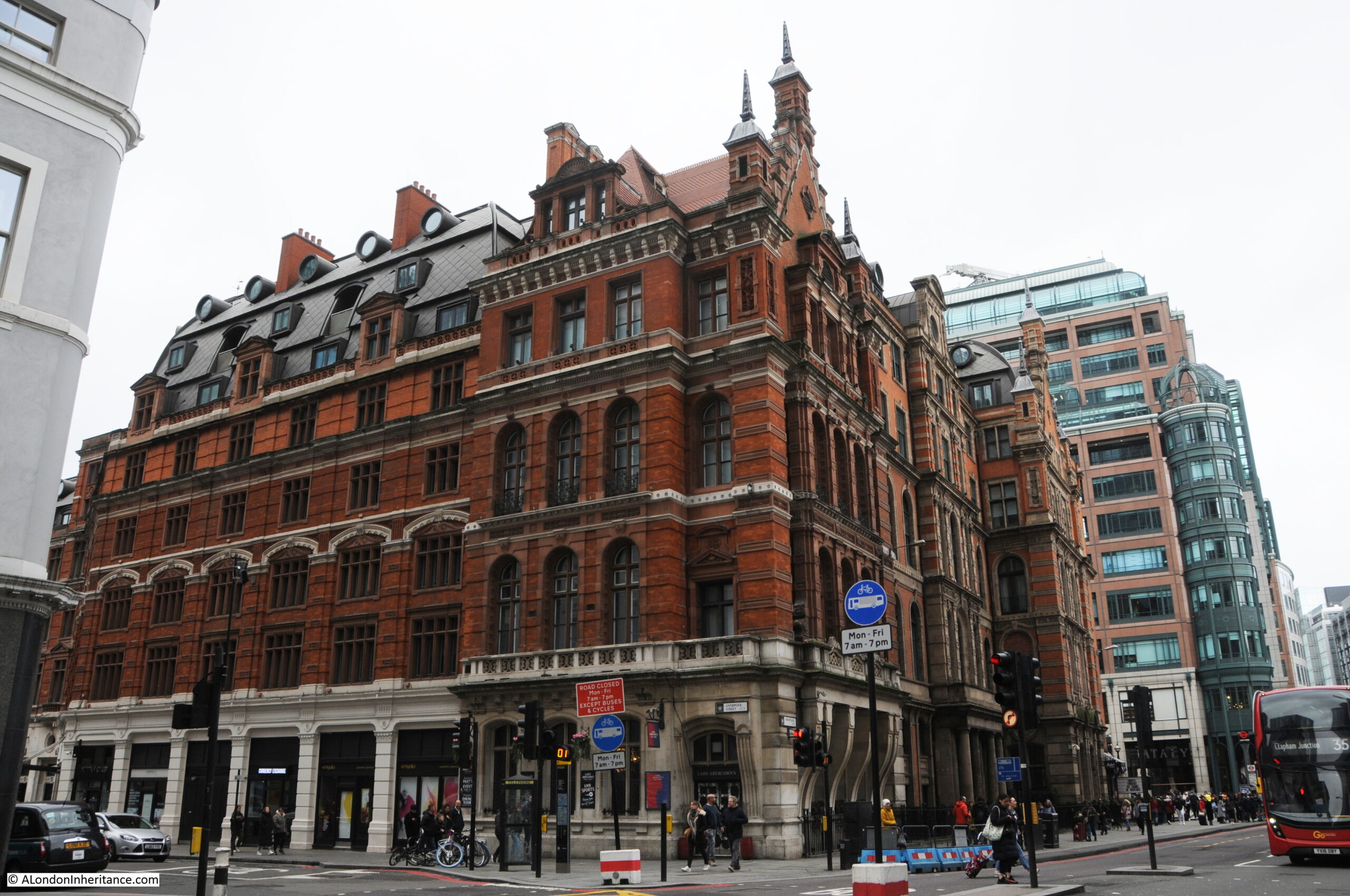
Liverpool Street Station, the development of the railway into Liverpool Street and the area in general has a fascinating history, which I shall return to, as the demands of a weekly post, as well as trying to limit my posts to 3000 words prevent inclusion in this post.
I have been waiting for the redevelopment of Exchange Square to complete, and I am really pleased that it is still possible to almost see the same scene as my father.
The details within the overall photo are also fascinating, and I shall leave you this week with the extract from the photo at the top of the post, showing a worker walking up to an engine. I do not know if he was the driver, but an everyday station scene from 71 years ago.
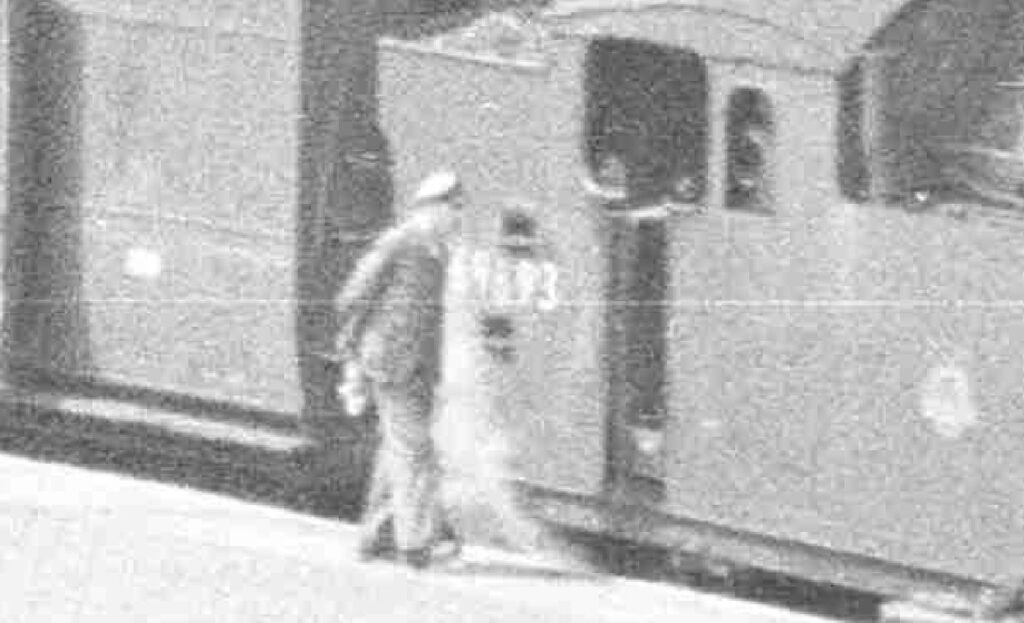
I just wish that I had taken some photos in all the years that I used Liverpool Street Station.

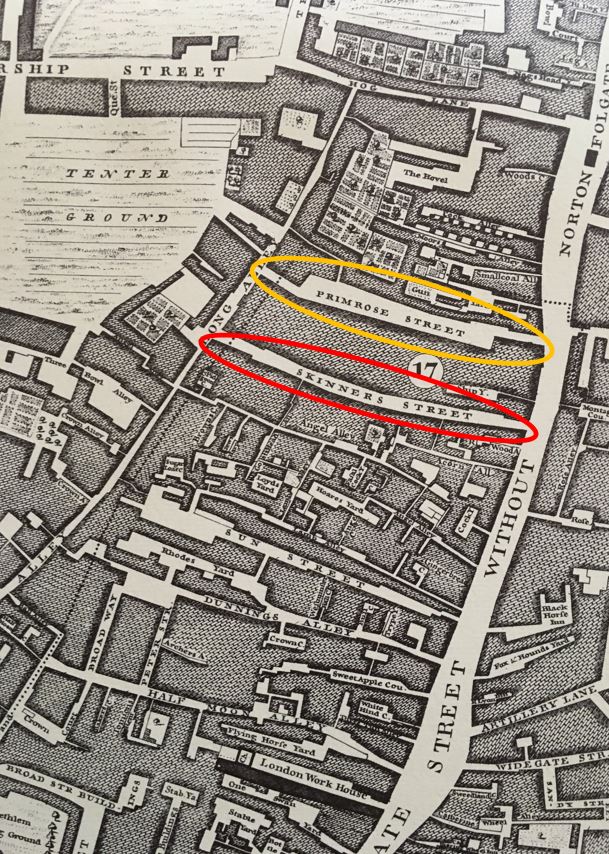
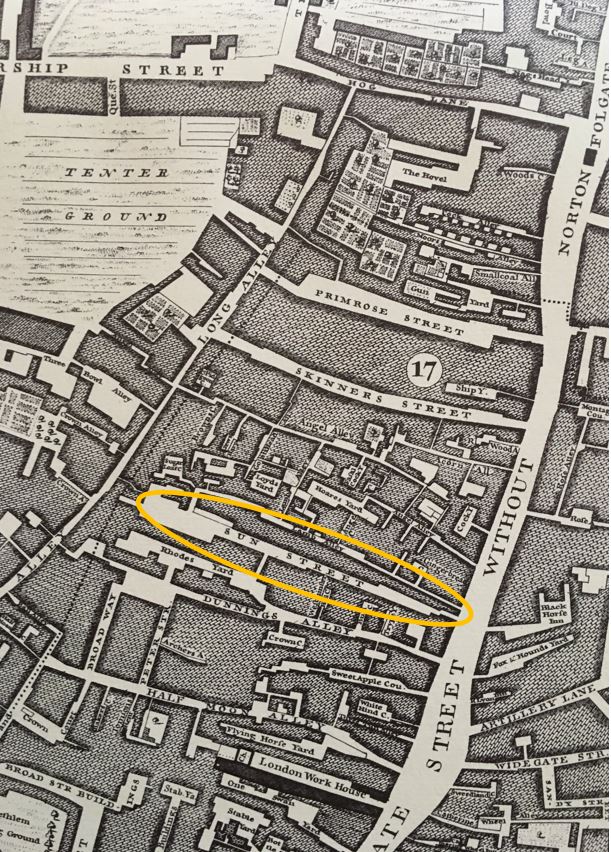
Great article about Liverpool Street Station. Exchange House is an incredible feat of engineering, I have been inside it many times and admired its clever construction. I too was a regular commuter to the station for very many years and have seen many changes there, mostly for the better I must say. However the new proposed development is totally wrong, out of scale and unsuitable for the site, and it must not be allowed to go ahead without significant change to the plans. Many thanks for an informative and interesting article.
I worked at the W H Smith bookstall in the late 50s and have clear memories of the station layout but can not orientate myself at all on the modern station. There is a splendid shot of my old workplace here.
https://blog.railwaymuseum.org.uk/old-morality-recreational-reading/
Turning left just past the bookstall was an underground toilet that also had baths. We had no such thing at home so I made full use of it.
I remember there was a doorway from the station to the Great Eastern Hotel.
Another memory was, in the days of steam, an ever present smell of fish.
Finally, I recall the glue pot in the left luggage office to apply labels to your bags or trunks on deposit.
Wasn’t the station a location in The Ladykillers?
I think that was King’s Cross.
The film Elephant Man with Anthony Hopkins and John Hurt made extensive use of Liverpool Street station for filming, internal shots. The film was also in black and white and shows the old walkways between platforms.
Hi I really enjoyed this blog. In the sixties I was a regular user of the pub on the corner of Primrose street and Bishopsgate. It was called, obviously The Primrose. I was a mod and the pub on a saturday had a resident live band called The Third Party. I used to meet up with friends I had travelled down from Wood Green in north London on a 141 bus that terminated at Finsbury Square and I would walk through to the west end of Primrose Street. My friends and I would offen walk down to Liverpool street station and wander around aimlessly late at night and like you I never dreamt of taking a photo!
I first traveled on a train from Liverpool Street in the mid 1940s to visit relatives who lived at South Woodford. Several years before the Central Line took over that section of track.
A number of years later I used the military trains to Harwich ( Parkestone Quay) when based in Germany whilst doing my National Service.
Your father ‘s photos were indeed taken from the top of the ramped approach to the station which was used by taxis and mail vans. I spent many happy hours in the late 50s and early 60s trainspotting from there, avoiding vehicles as I (and dozens of others) rushed from one side to the other to spot a new arriival. Beyond where the locomotive with its driver or fireman is standing were the local commuter platforms, an intensive service. In the middle of the station were the long distance trains to Harwich, Norwich etc and on the far side of the tscene shown in the second photo were trains to Shenfield and south Essex.
I have commuted for 39 years to/from Liverpool St. My earliest memories aged about 12 were of my father parking in Broad St which was a bombiste car park – very up and down with much rubble circa 1973.
There was a ramp going down to Liverpool St station itself which one could drive down. The place was filthy dirty and very dark.
The redevopment was rapid and the last film I can think of was Elephant Man with John Hurt circa 1980-81 from memory, shot on the gangway inside the station and in the male toilets which were near Platform 1-3.
Before the imminetn redevlopment the Victorian Preservation Society worked tirelessly to save the Station as it was but too many commuters were fed up with the delapidations and filth. I think they were partly successful. It’s beginning to look tired again and needs some tlc.
Take a look at the War Memorial near McDonalds. It is very humbling. Hundreds of names of those who worked the LNER? Until recently the Salvation Army played annually at Christmas at the top of the escalators near the War Memorial. They always struck me as a gentle reminder to us City chaps how lucky we were.
Old Broadgate Station after 45 years became first Broadgate Circle and then that was demolished and we have what you see today.
Thank you for your article. Fond memories of a true Victorian masterpiece. I’m so pleased they saved the War Memorial from the wrecking Ball.
Like you I was using Liverpool Street Station regularly about the same time you were but in my case to go to Norwich. Different trains but I do have nostalgia for the old slam trains.
I note your comments regarding the proposed redevelopment of the station and demolition of the towers etc. I do agree with these comments it seems these days everything has to be spectacular to the extent the original function is ignored. As you say I am sure the traveling public would much prefer the function I.e. an efficient and affordable railway service .
Also I would like to add that I have a recollection of reading in one of Charles Dickens novels an account of the chaos of the building of the original railway system through the city with peoples property treated with callous disregard . For me this is highlighted by using the early maps to show the streets that no longer exsist as they were swept away with the building of both stations. It seems we learn nothing as the costs of the much heralded hs2 railway will be borne by the PBI yet again as now our precious countryside is ripped up to speed the thing along its greedy path.
Interesting post as always. The difference in the roof appearance is because the dirty-looking “glass” is actually not glass, but some sort of polycarbonate-like glass substitute installed when the roof was refurbished around the early 1980s and metalwork painted brown. The clean glass is that installed where the roof (painted blue) and platforms 1-8 were extended at the London end, in the late 1980s redevelopment that replaced the old buildings along the former access ramp from Liverpool Street itself. A fascinating video tour of the station as the development started is here: https://youtu.be/TrJnbOQ9_Us
Ive just left London to live in Harwich broad st was the station i used the most as i was on the north London line. There is a similar statue of the kinder transport children on the quay at Harwich and the house weve bought was built on the site of the holiday camp where they were housed at Dovercourt.
Many thanks for this article, I loved reading it and studying the maps and photographs. I worked in the City nearby from early 1980s to early 2000s and often explored the area around Liverpool Street station. This brought back happy memories of my walks! Thank you from Joss Mullinger
More impressive than Exchange House is the engineering behind 201 Bishopsgate and Broadgate Tower (SOM Chicago, 2006-08) whuch you allude to but don’t directly cover. ‘Street’ level is as you say a concrete raft several metres above the railway tracks but it was designed for an earlier, lower scheme; as it was no longer possible to sink additional piles once a tower had been committed to, a five-storey-high steel A-frame was added to divert part of the tower’s weight to more of the original piles – this is why you see that dramatic structure today.
Another wonderful post triggered off by your London loving father’s invaluable hobby. Thank you. Would you be willing to tell us actually about your father a little more. Reading your posts I keep on wondering what sort of man he was, what was your experience of him. Of course if this is of no inconvenience.
If I am not mistaken others would also be interested, after all you would not take us to these unique weekly ‘journeys’ without his input.
PS. Does the British Library have a copies of all the London Inheritance posts?
Fond memories of the steam engines. Liverpool Street : Gateway to Enfield Town!
Great post today. Really enjoyed reading it, the old trains had a particular smell not sure what it was, not unpleasant. I remember using those small carriages as a changing room when travelling up to London for a night out when I lived in the sticks. Oh those really were the days.
Like many of those who have posted above I have memories from yesteryear of using Liverpool Street station as both a child and in later years. I am not quite old enough to remember the days of steam but as a child there were regular trips to see my grandmother who, then, lived in far away Chadwell Heath.
I well remember the tortuous journey on the Northern Line, a long walk and reminders to ‘mind the gap’ at the Bank and then catching what I think were even then still the original 1940’s electric trains. In my head I can still hear the tannoy announcement ‘the next train to Ilford, Romford and all stations to Gidea Park’, which mean we needed to get a move on.
In the early 1980’s I remember what then felt like the decadence of paying £4 to have my suitcase sent on ahead to Germany so I could travel light on a very overcrowded boat train to Harwich and the Continent.
To my mind the atmosphere of the old Liverpool Street station is best captured in the prints by Edward Bawden, not least the old square hanging clock. Let us hope that the current redevelopment plans, which to my mind at least, are all about profit over people, are reconsidered and that the architecture of what remains of this fine old station will live to be appreciated by future generations.
Finally, a word of appreciation and thanks to the blog author. It is always a joy and welcome diversion to see and read each week.
I used Liverpool St as my daily commute, but what always fascinated me were the stone blocks, pillars or memorials. They were on the left as the (Southend) trains entered where the rails went underneath ground level. After them, of course, are the deserted platforms that seem to be in the middle of nowhere, with stairs leading up to the ground. I stopped commuting 2011 and always spent lunchtimes exploring the whole city area. If only I had your blogs then to fully understand what I usually saw, but just walked by, without giving it anymore thought!
Your father’s photos, particularly the small detail of the railway worker, brought back memories of the smell of the station in the 1940s when I arrived there with my mother from Ipswich on our visits to London and later on many memorable occasions (first trip abroad alone, going up to university, and one occasion when I was standing in the corridor crying after parting from a boyfriend the kindness of a ticket inspector who put me in First Class (perhaps he was afraid I was a potential suicide).
Liverpool St station and the Great Eastern Hotel form the backdrop to W.G. Sebald’s novel ‘Austerlitz’ (about a kinder transport survivor from Prague who is trying to recover his past). From pp. 127-132 Sebald imagines the Victorian excavations for the twin stations of Broadgate and Liverpool St, evoking the many layers of the past and the burial grounds beneath them, including the priory of St Mary of Bethlehem and the hospital for the insane known as Bedlam. Further exploration for another of your wonderful posts perhaps?
Thank you for another fascinating slice of London history. As an East End urchin, I used to frequent Liverpool Street station with my two brothers and other members of our ‘gang’ during the late 1950’s. I remember the main entrance being from Bishopsgate. I think that a wide staircase immediately descended to the concourse, but I am happy to be corrected. However, to the right of the main entrance was another narrower staircase which descended to the right when entering the station, hugging the wall, so to speak. What was of interest to us was a cast iron machine which was situated just around to the left at the foot of the staircase. This machine was provided for the purpose of producing aluminum labels to attach to luggage for the princely sum of one penny. The machine had a cast circular face which included the letters of the alphabet. It may have included numbers but my memory fails me on this point. A large central metal arrow had to be turned to each letter in turn and you pushed down hard on a lever on the right of the machine to stamp each letter.
I also remember a footbridge which went across many of the platforms somewhere between the concourse and the platform ends. This footbridge eventually led you to a door, and on passing through you found yourself in an alleyway between Liverpool Street and Broad Street stations. This must be Sun Street Passage as mentioned in the article.
As regards the ramp leading from Liverpool Street down onto the concourse, I remember the Scammel Scarab lorries in British Railways cream and red (blood and custard) livery, darting in and out of the station.
As regards the proposed destruction, sorry redevelopment, of the station, I read elsewhere that one of the reasons given for the proposal is the current overcrowding. Apparently this will be cured by introducing more retail units and making the station a ‘go to venue’. So, it’s already overcrowded and the solution is to attract more people to shop and socialize. Surely passengers just want to be able to catch a train without tripping over people who have no intention of travelling anywhere?
And lastly, I find it ironic that someone thought it appropriate to include an art work entitled ‘rush hour’. As if commuters need to be reminded of the daily misery called commuting! You couldn’t make it up!
Hello. Another fascinating piece. You might be interested to see some of my pics of Liverpool St taken around 1980 before its redevelopment, which the Gentle Author kindly published last year
https://spitalfieldslife.com/2022/07/22/david-johnsons-east-end/
All the best
Very interesting, as always!
What a wonderful post. I really enjoyed reminiscing about my train-spotting days 1952-1956 approximately, I was 8-12 years old and will never forget the excitement of seeing the large powerful express engines exiting from the bridges and thundering into the platform area. There were never less than 30/40 young boys at the end of the longest platform (you could buy a platform ticket then for a few pence). I used to go to all of the main railway terminals at the time but Liverpool St was always the favourte as I lived only walk away in Bethnal Green
Thank you for all your posts, I look forward to them very much as I worked in the City for almost 40 years.
John Daltrey
in school hols in Ipswich three time a year we used to travel up by steam train pulled by a locomotive named The Broadsman, departing Ipswich at 0910, poss ETA L’pool St 1015. I stand to be corrected.
Train probably started Norwich
Quite a lot of change since I was last in Exchange Square! As I recall, there was a reconfiguration of the square about 20 years ago, but now there is no large lawn or rock-strewn waterfall.
Good to see that Botero’s “Fat Lady” is still in the same place. Segal’s “Rush Hour” was moved from Finsbury Avenue Square, where it was outside the UBS building (as was) for many years. It seems a little hidden away and lost in its new position. The Lipchitz statue of “Bellerophon Taming Pegasus” has also been removed – I hope that will reappear somewhere?
Absolutely fascinating article.
The station concourse was the unexpected host of a flash mob event in August 1967. [Flash mob: a group of people who converge on a spot with little forewarning, perform some action (usually a protest or a dance) and disperse quickly.]
I had a phone call from a school chum suggesting we meet there at 5pm to welcome the Ipswich train which would be carrying DJs and crew from the pirate ship Radio London anchored off Frinton. The radio station had closed down forever at 3pm that day.
I wasn’t expecting any more than a handful of people to turn up. Imagine my (and the station master’s) surprise on finding the concourse packed with us teenagers and twenty somethings, all keen to spot their favourite DJs, to generally commiserate on the sad event, and to undertake some token shouting. Would I be able to find my school chum? Yes surprisingly I did. Perhaps his ever bright red hair helped.
A historical event, I suppose one could call that. It’s good that it can take its place in our city’s rich past, and good to be able to report on it with an “I was there” perspective.
Hi Does anyone know what platforms trains bound for Ipswich left from in 1975? And are the platform numbers the same today as they were in 1975. Many thanks for any information you can provide.